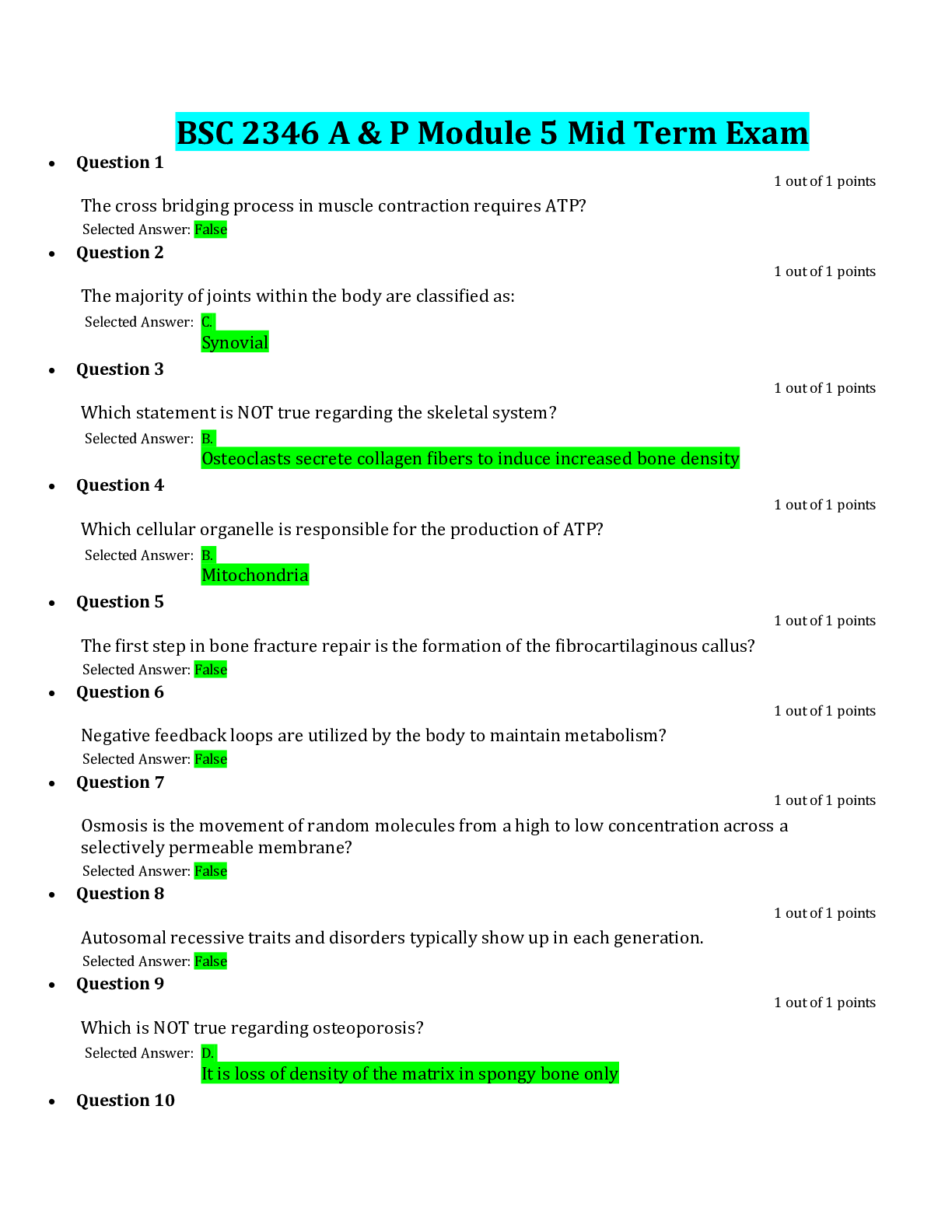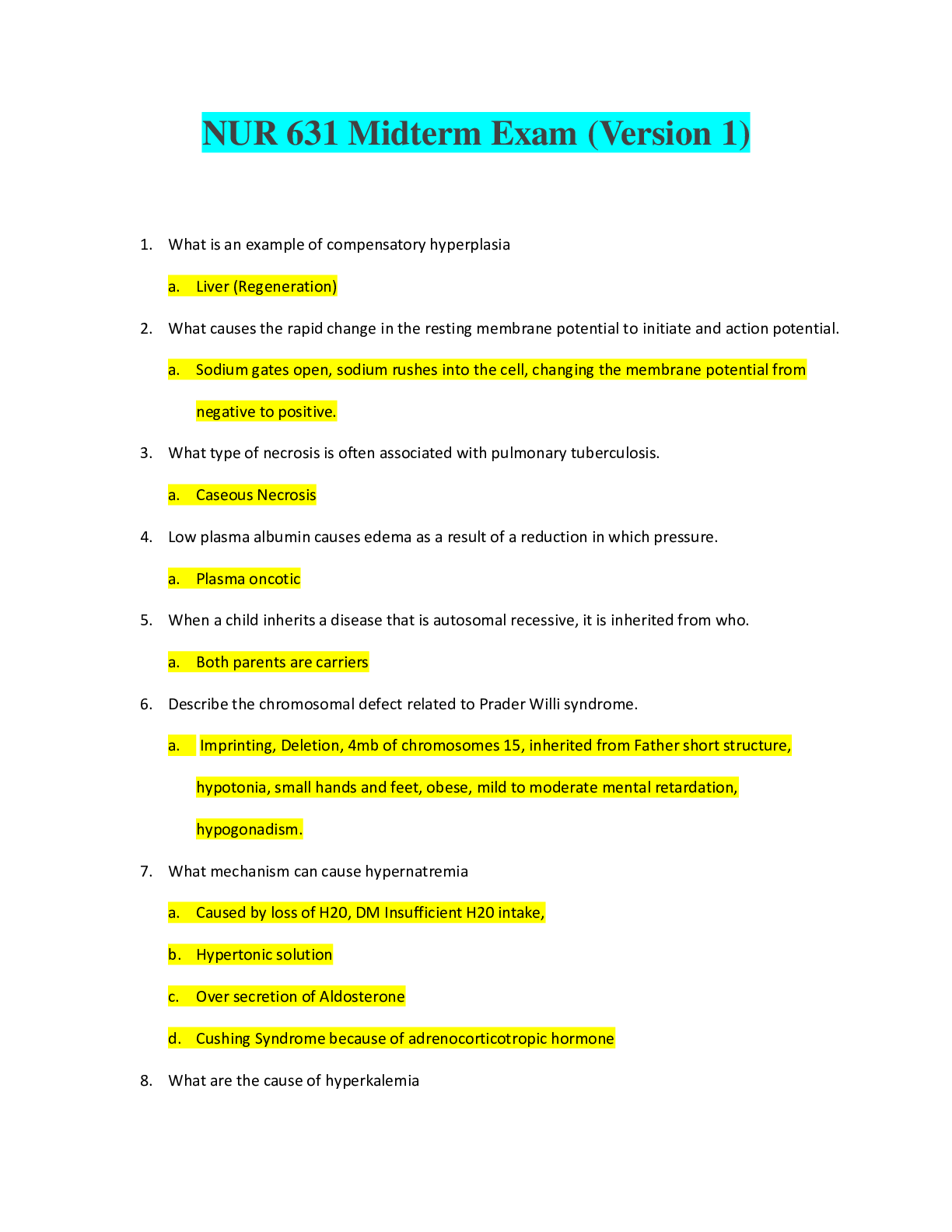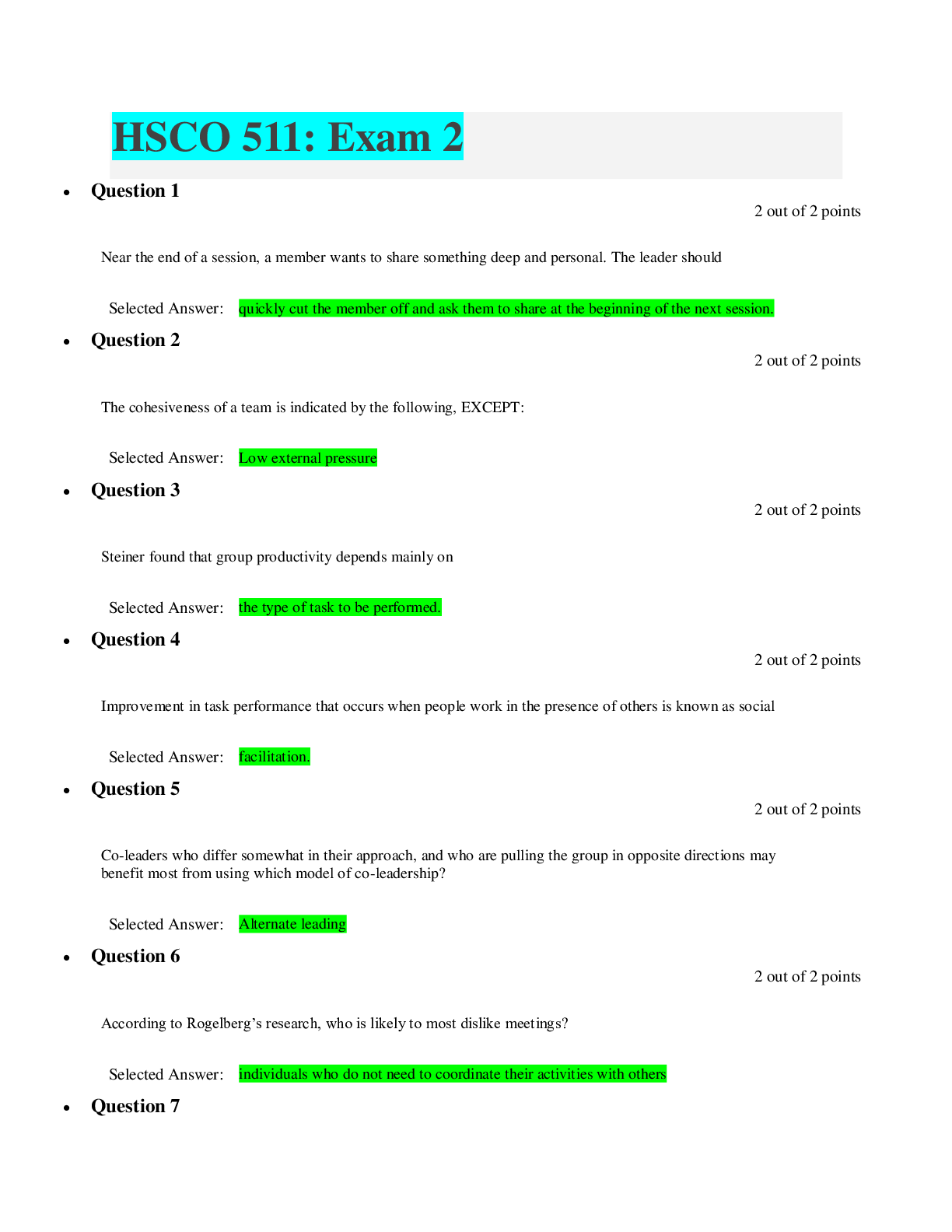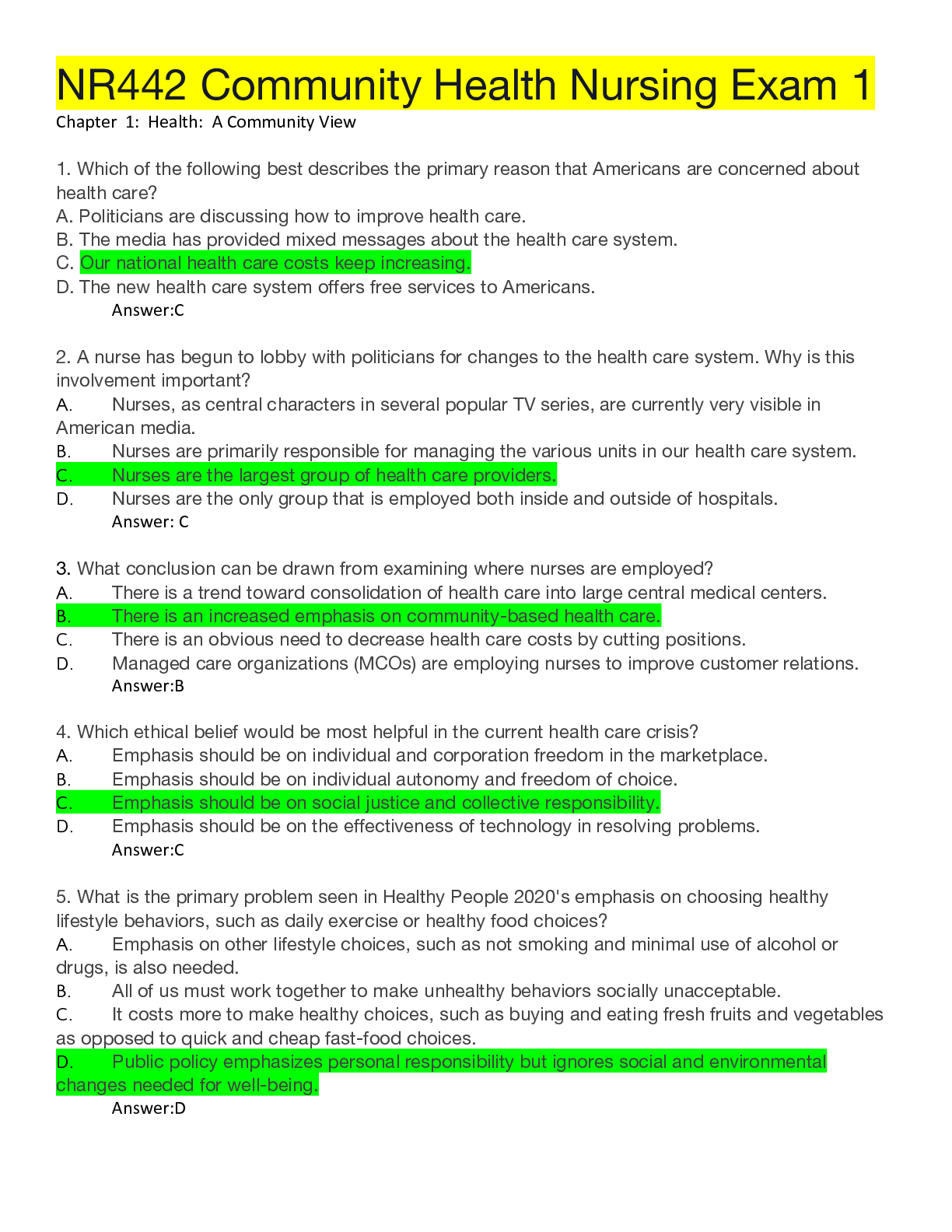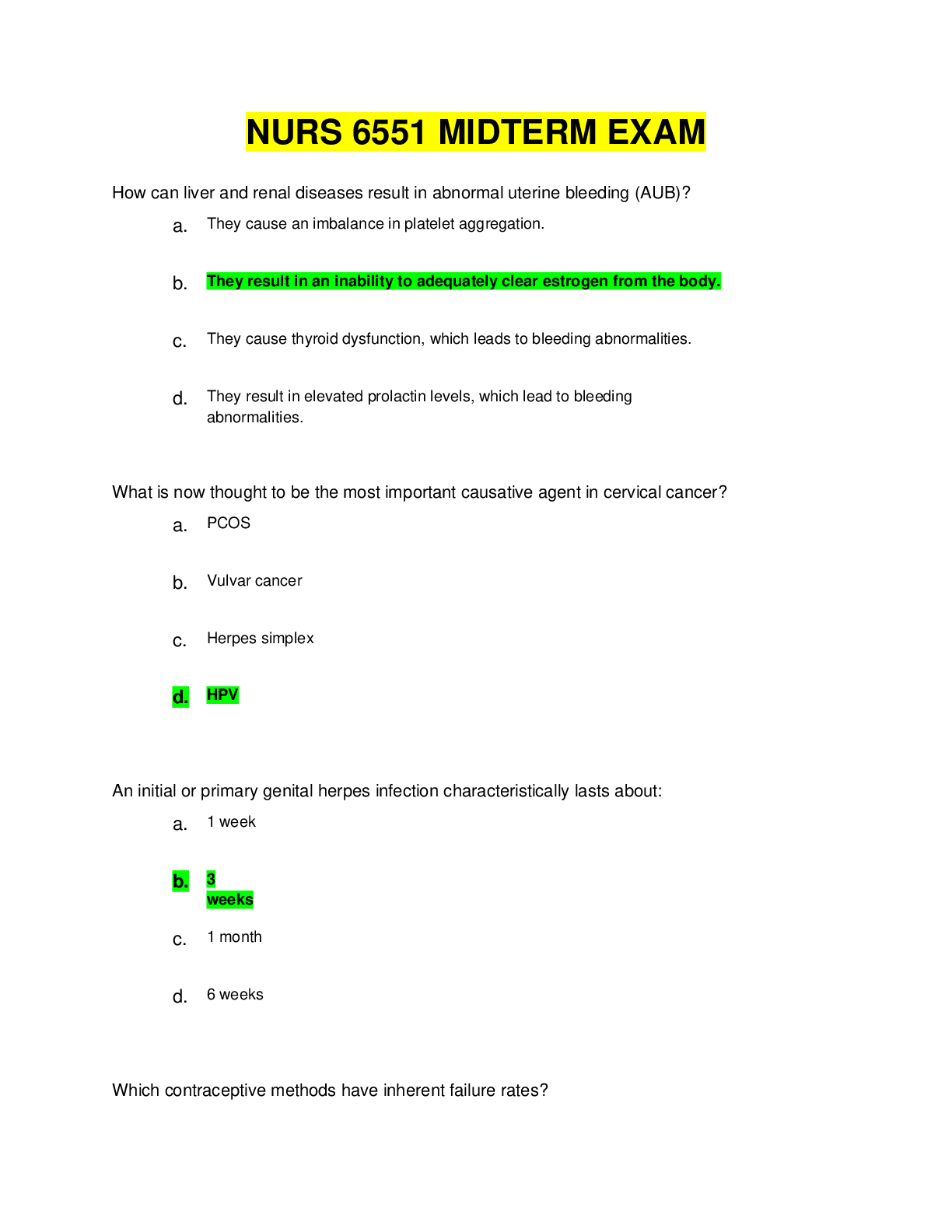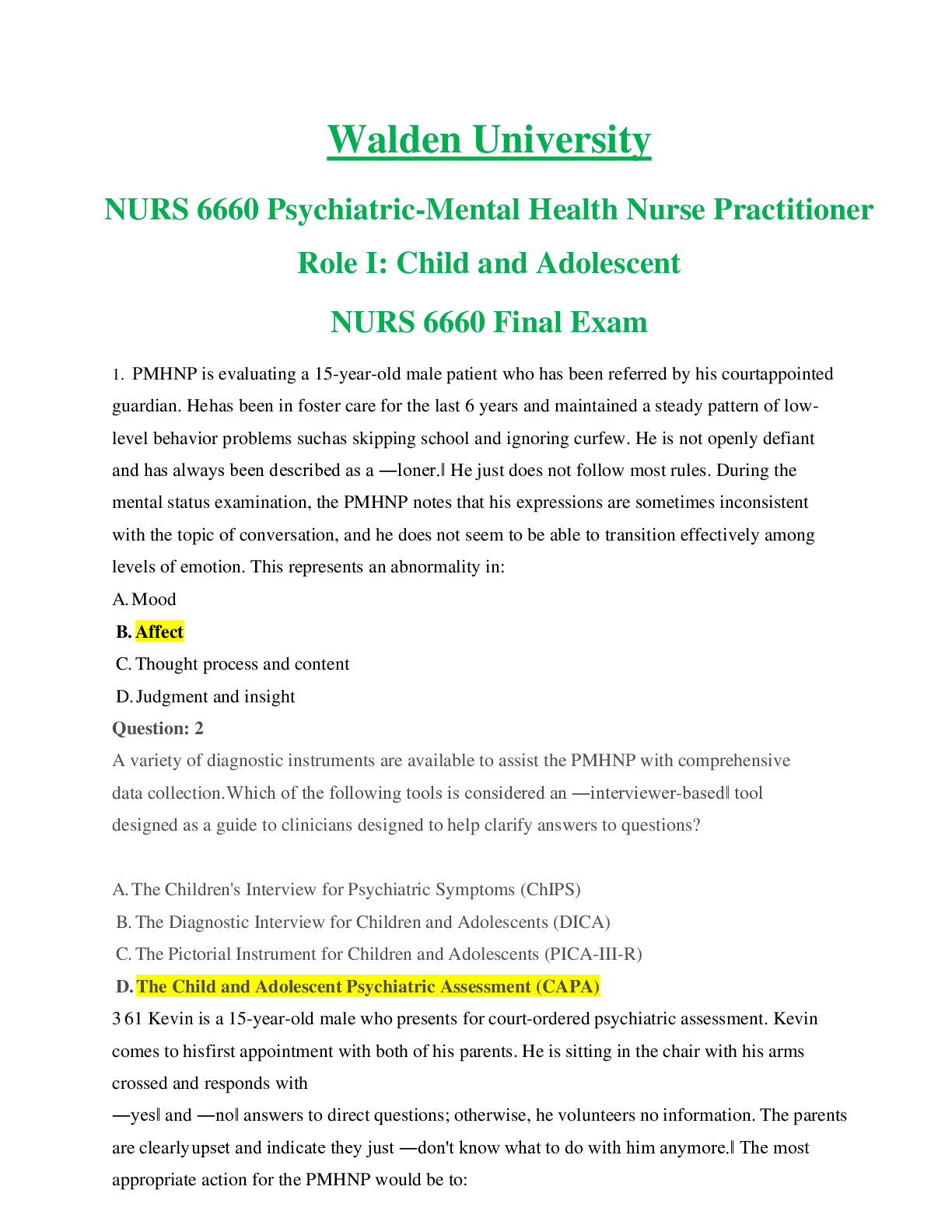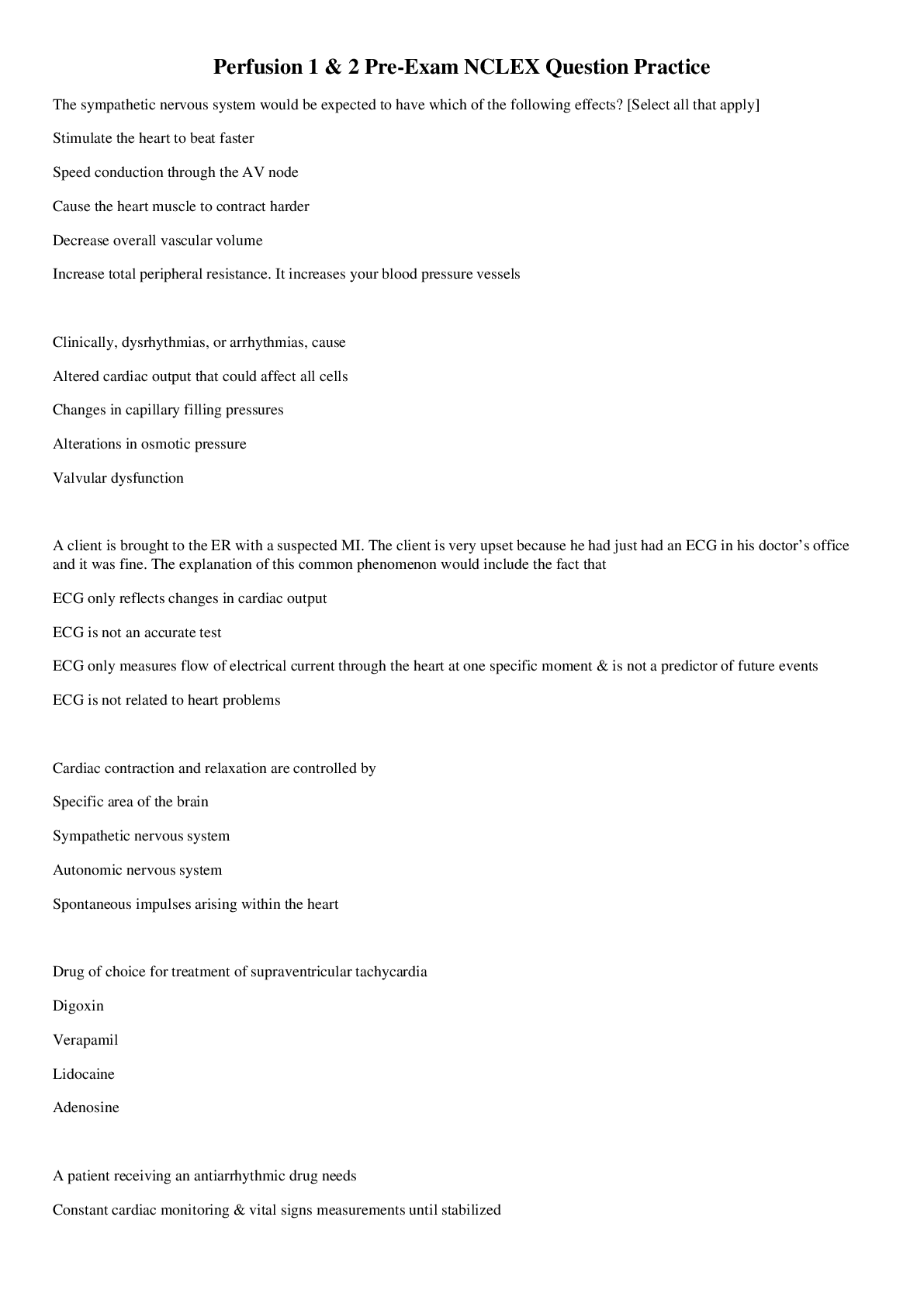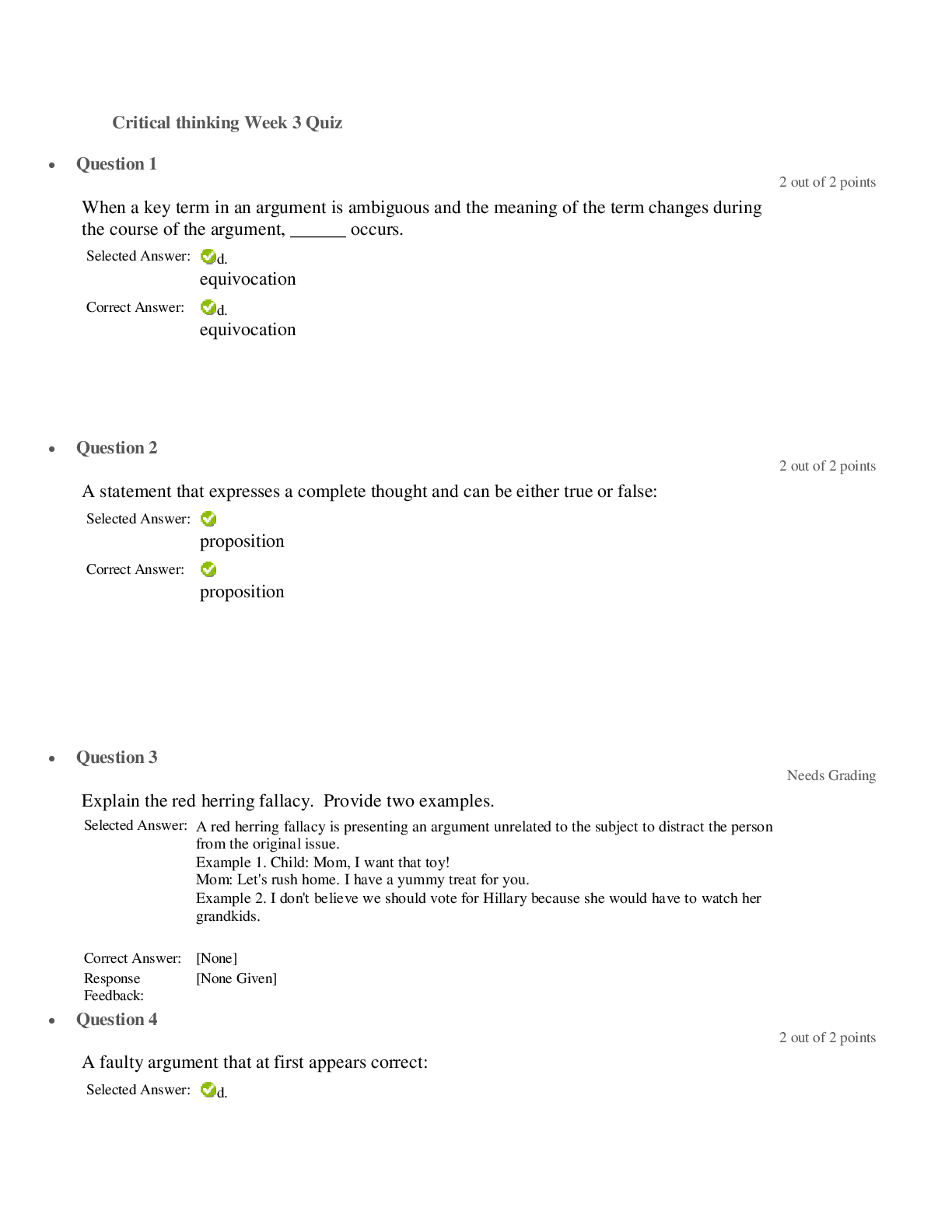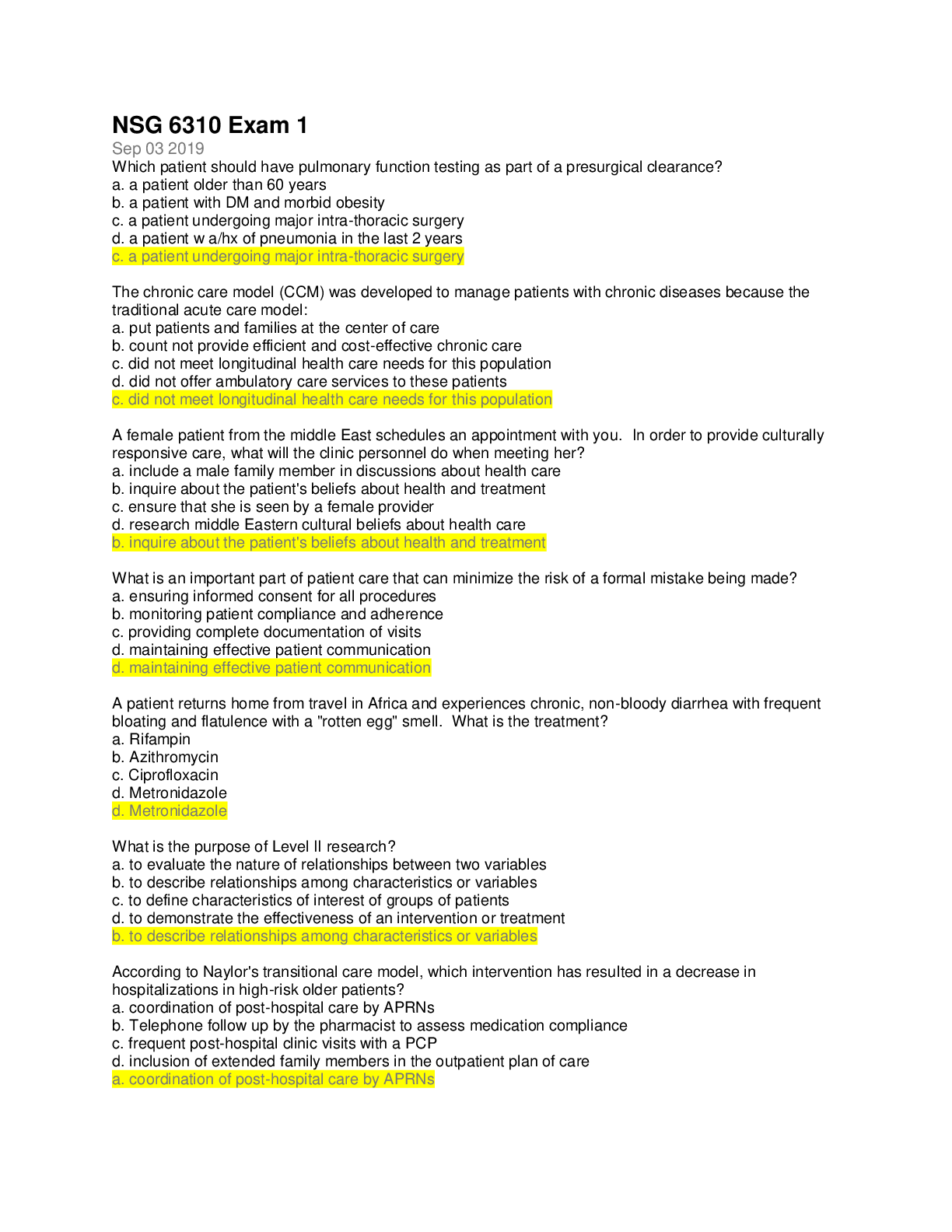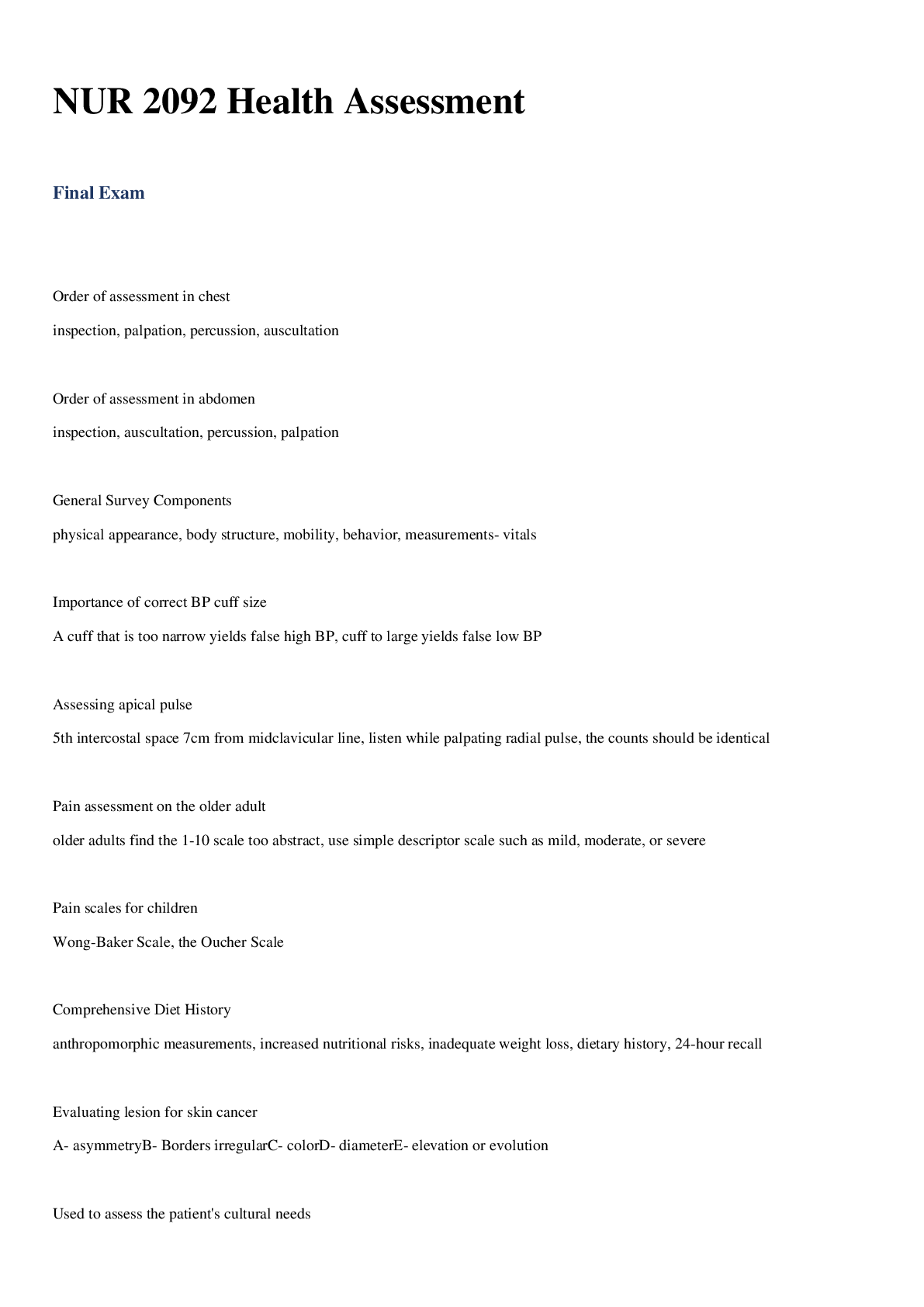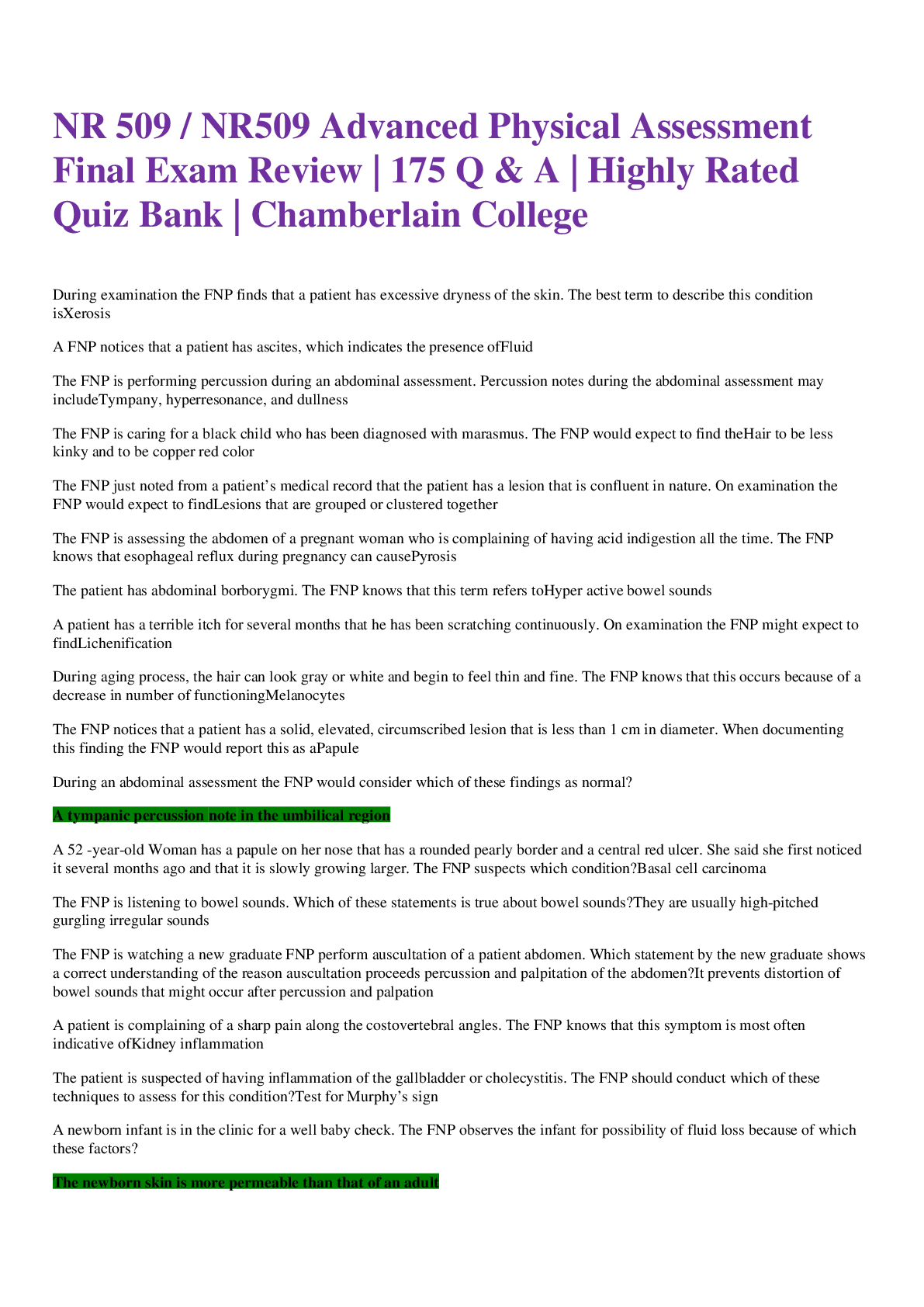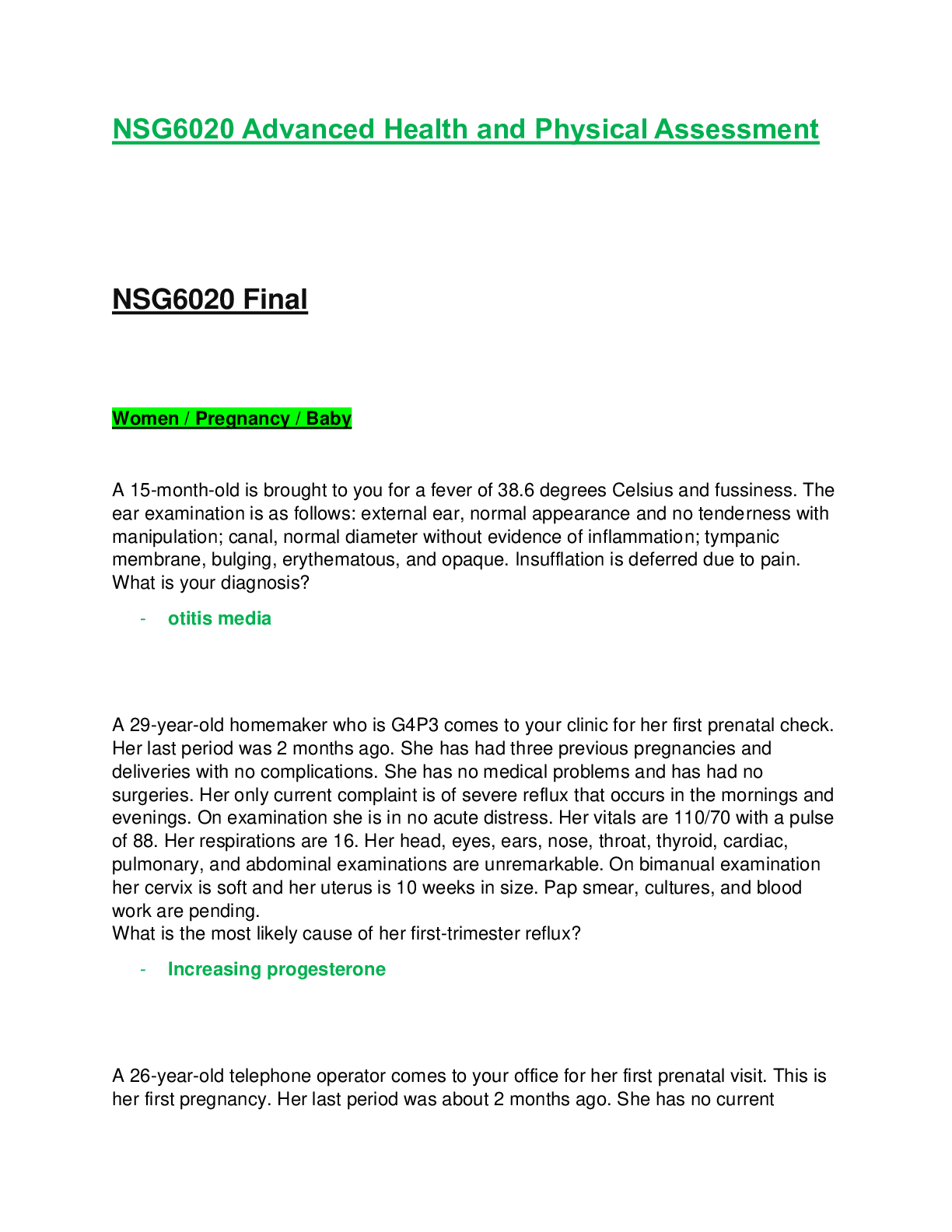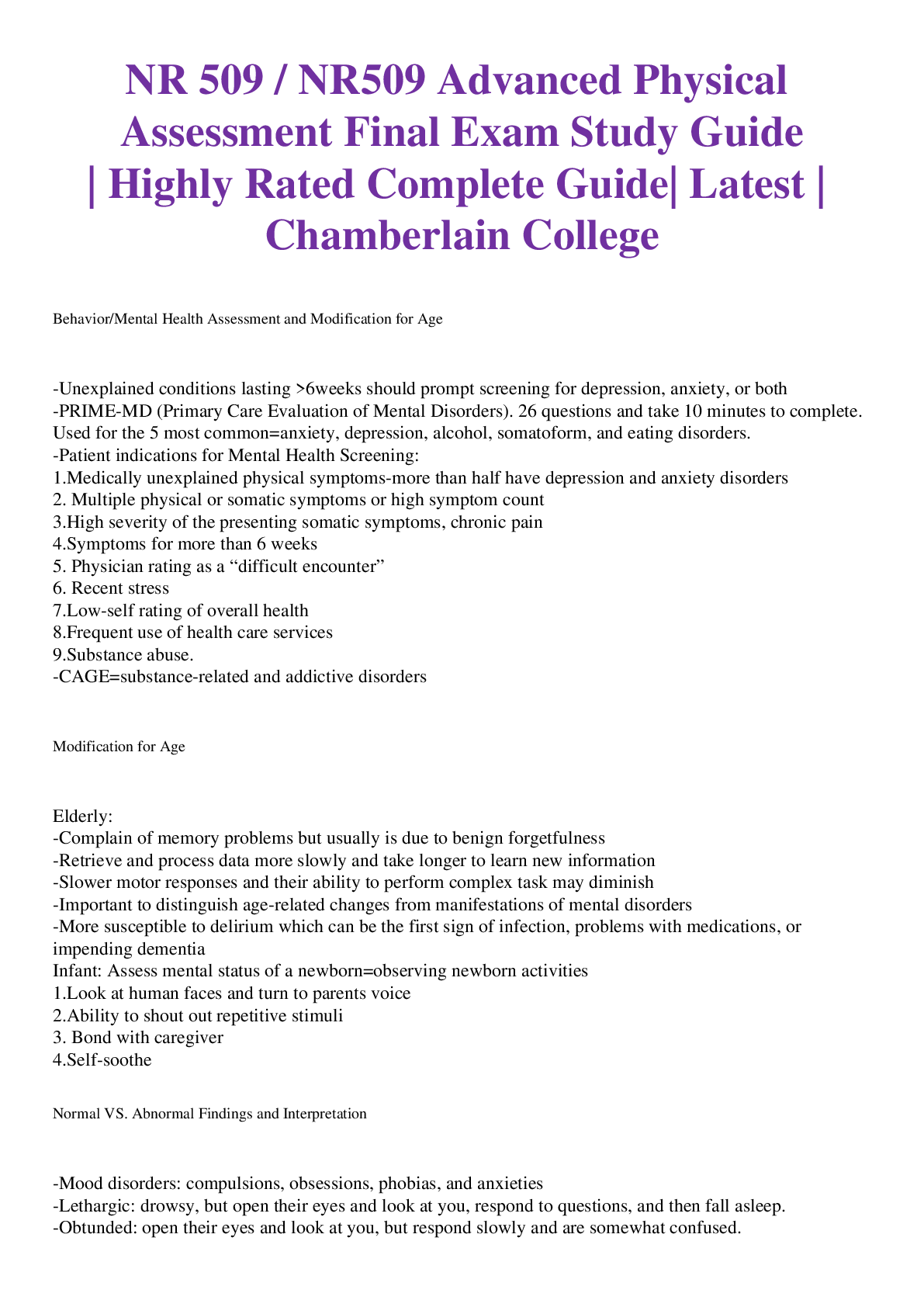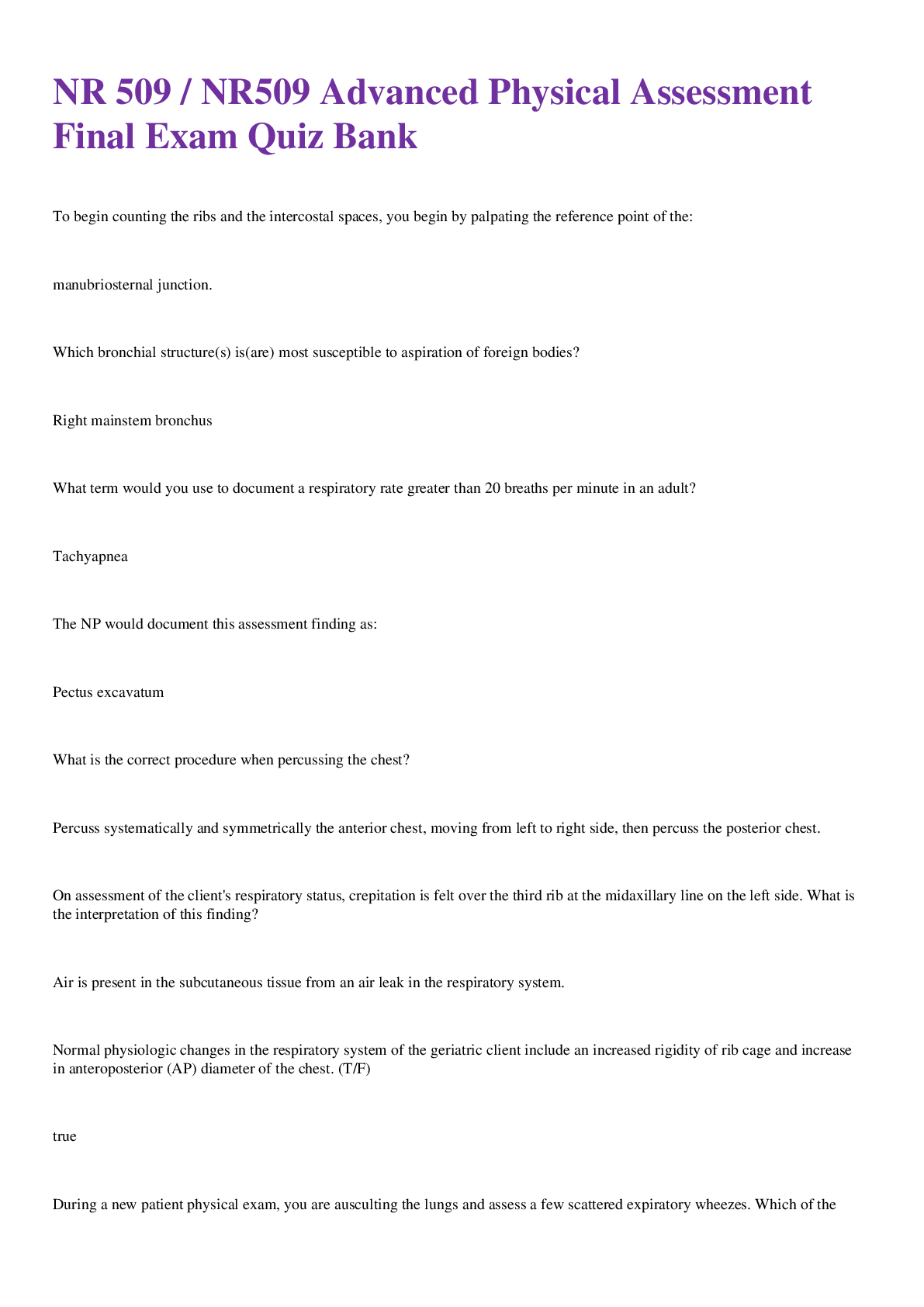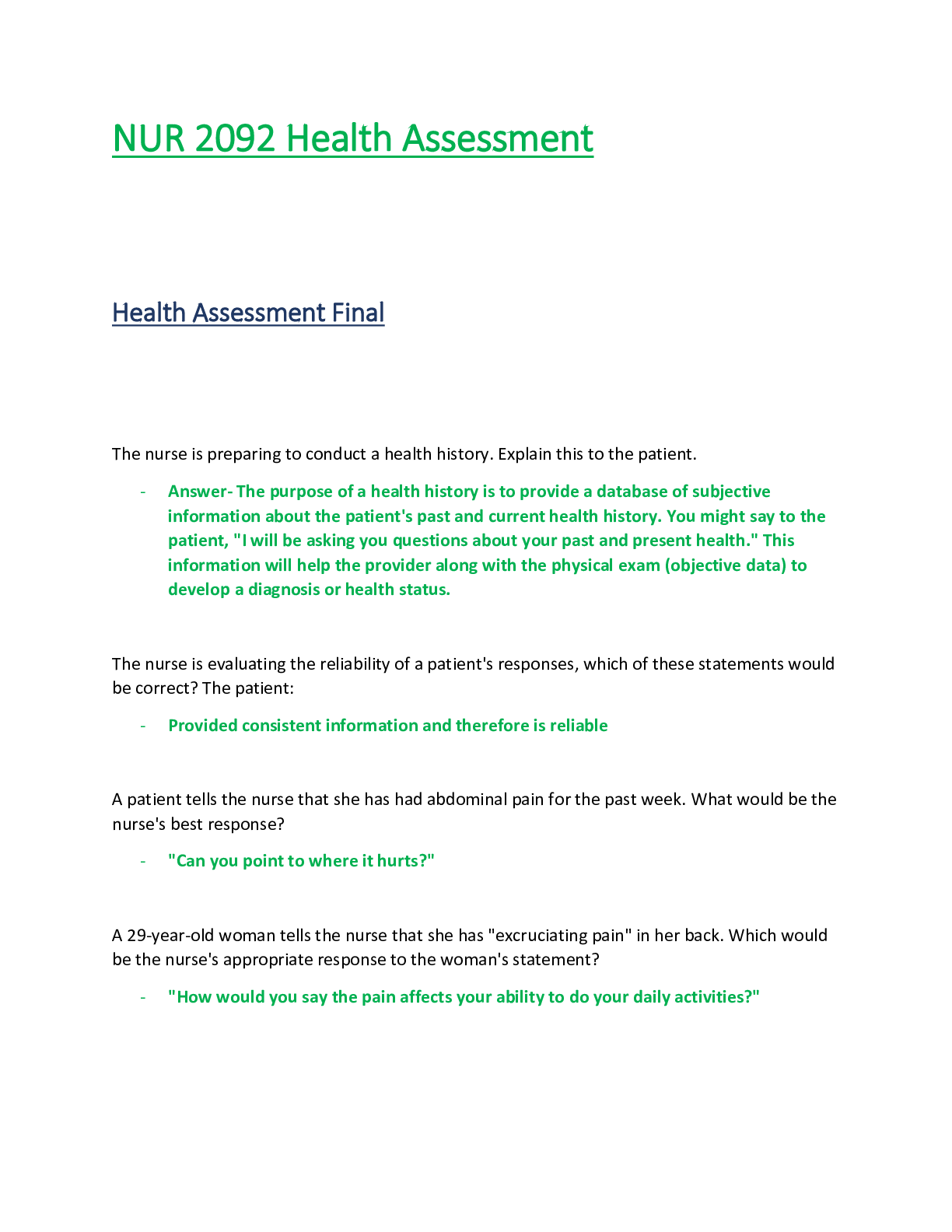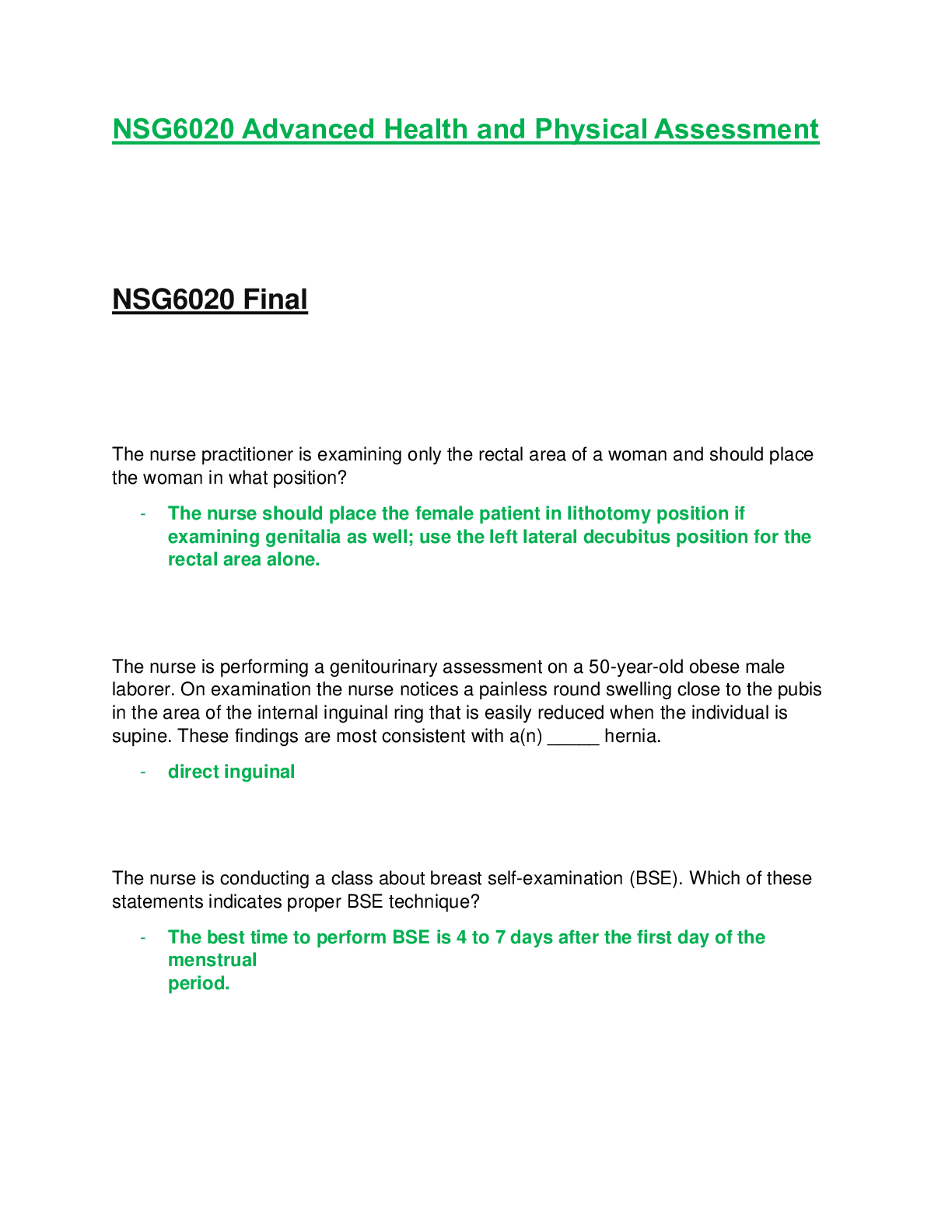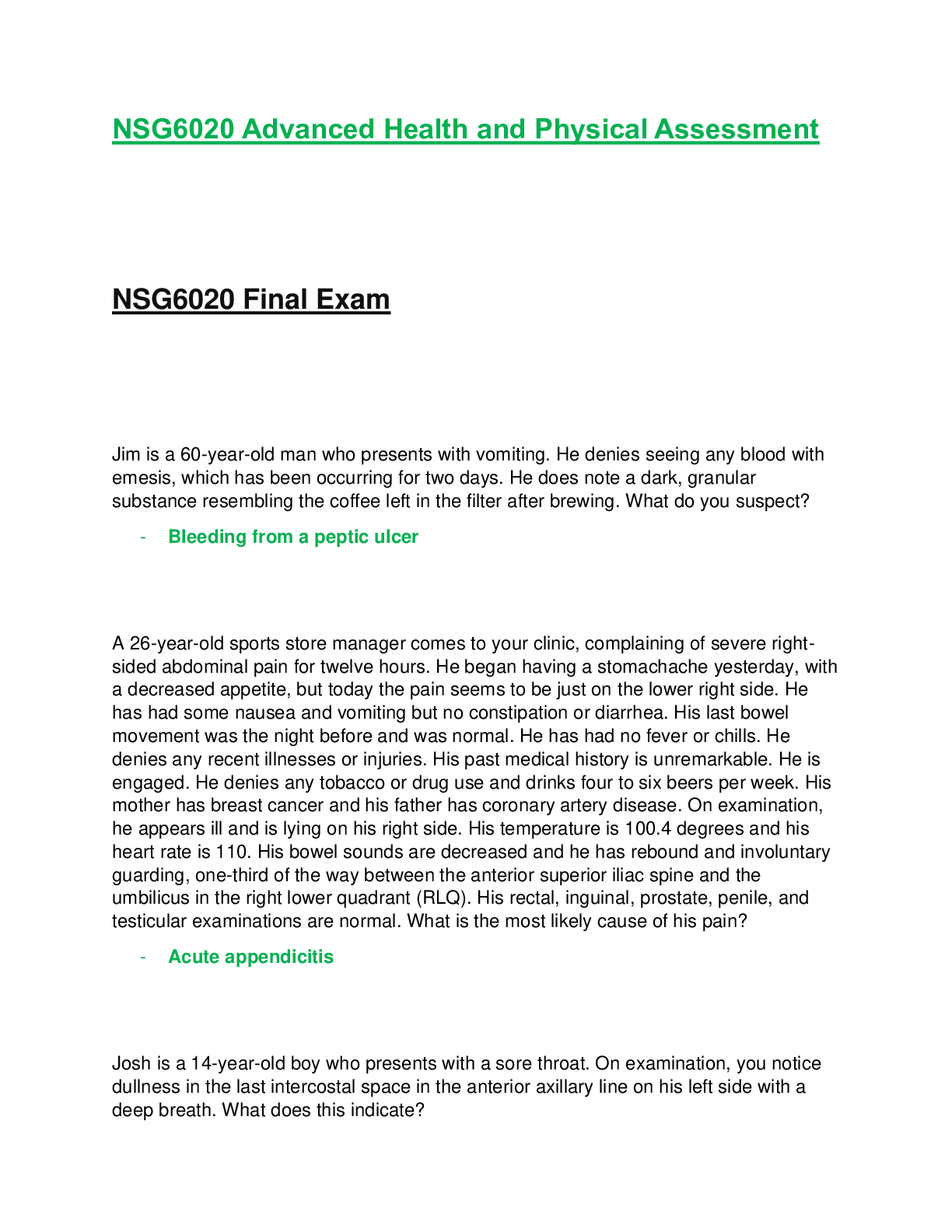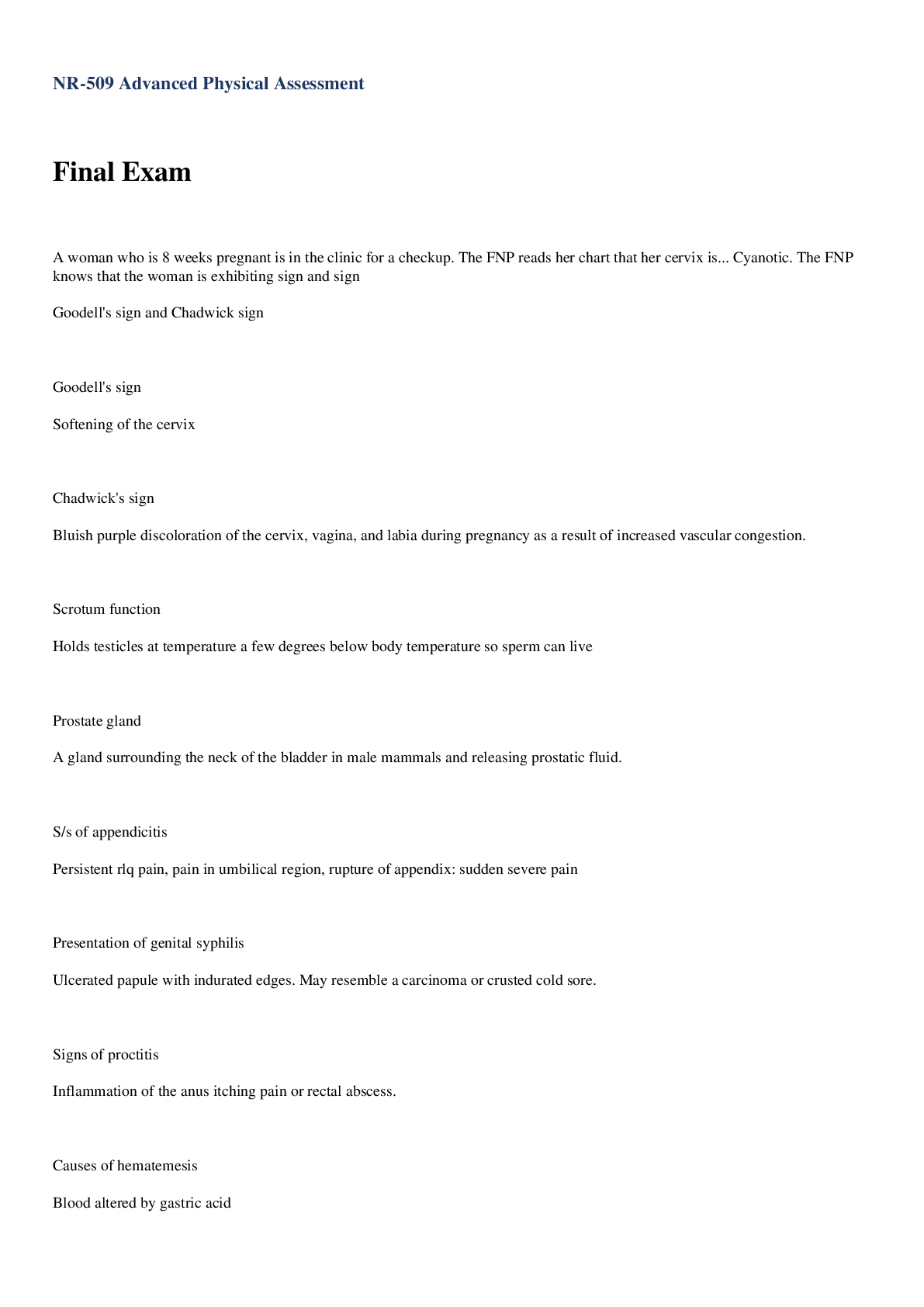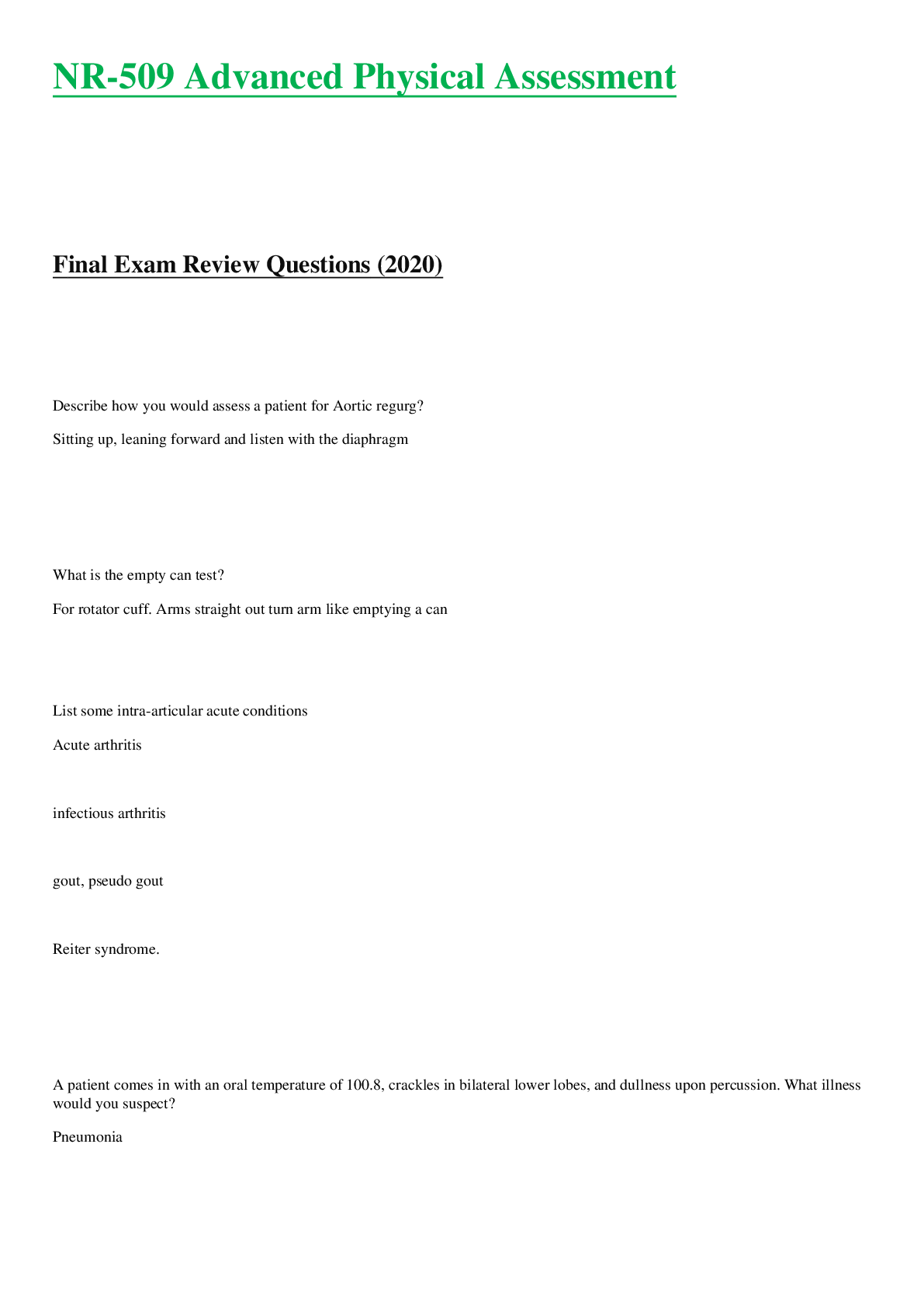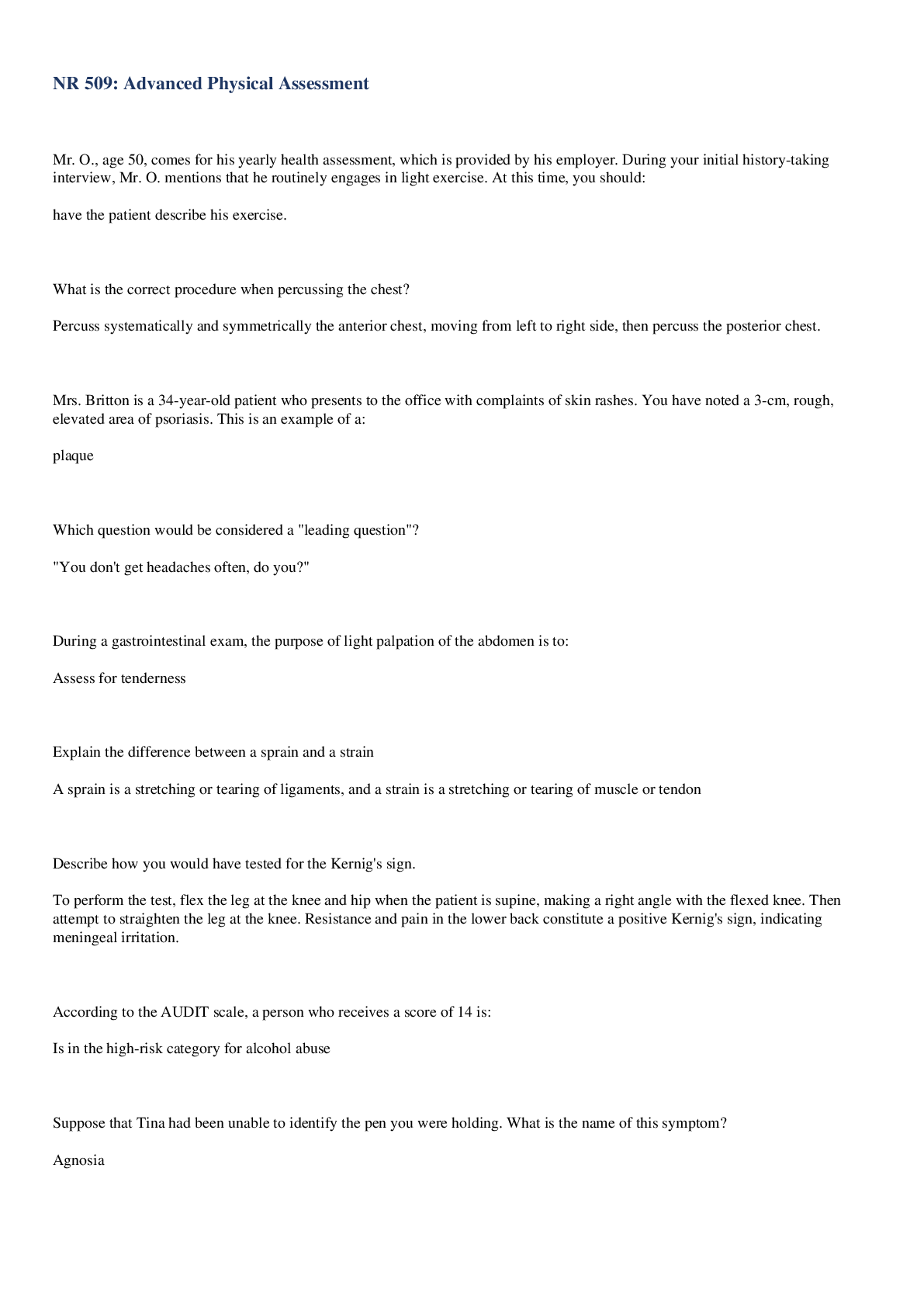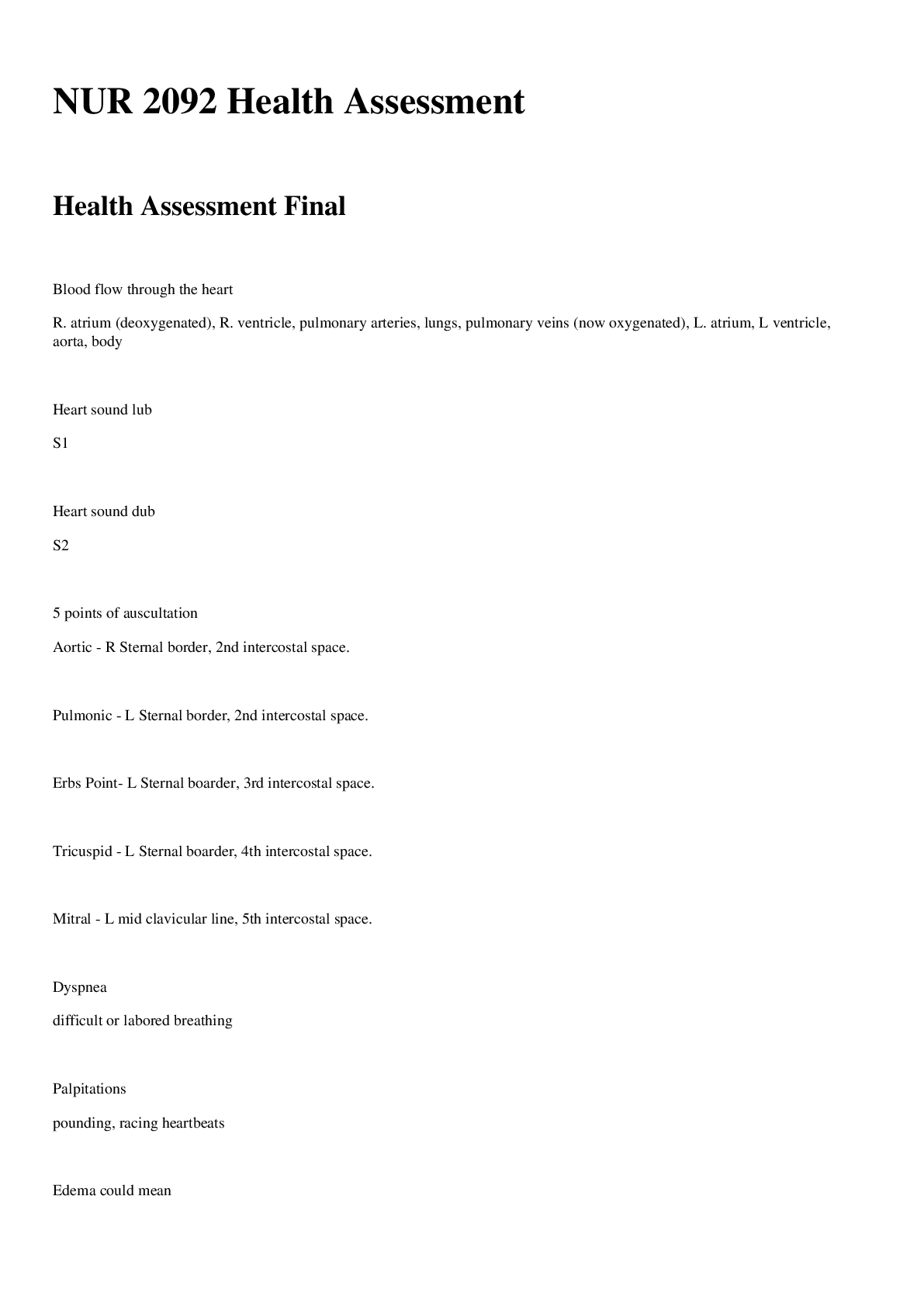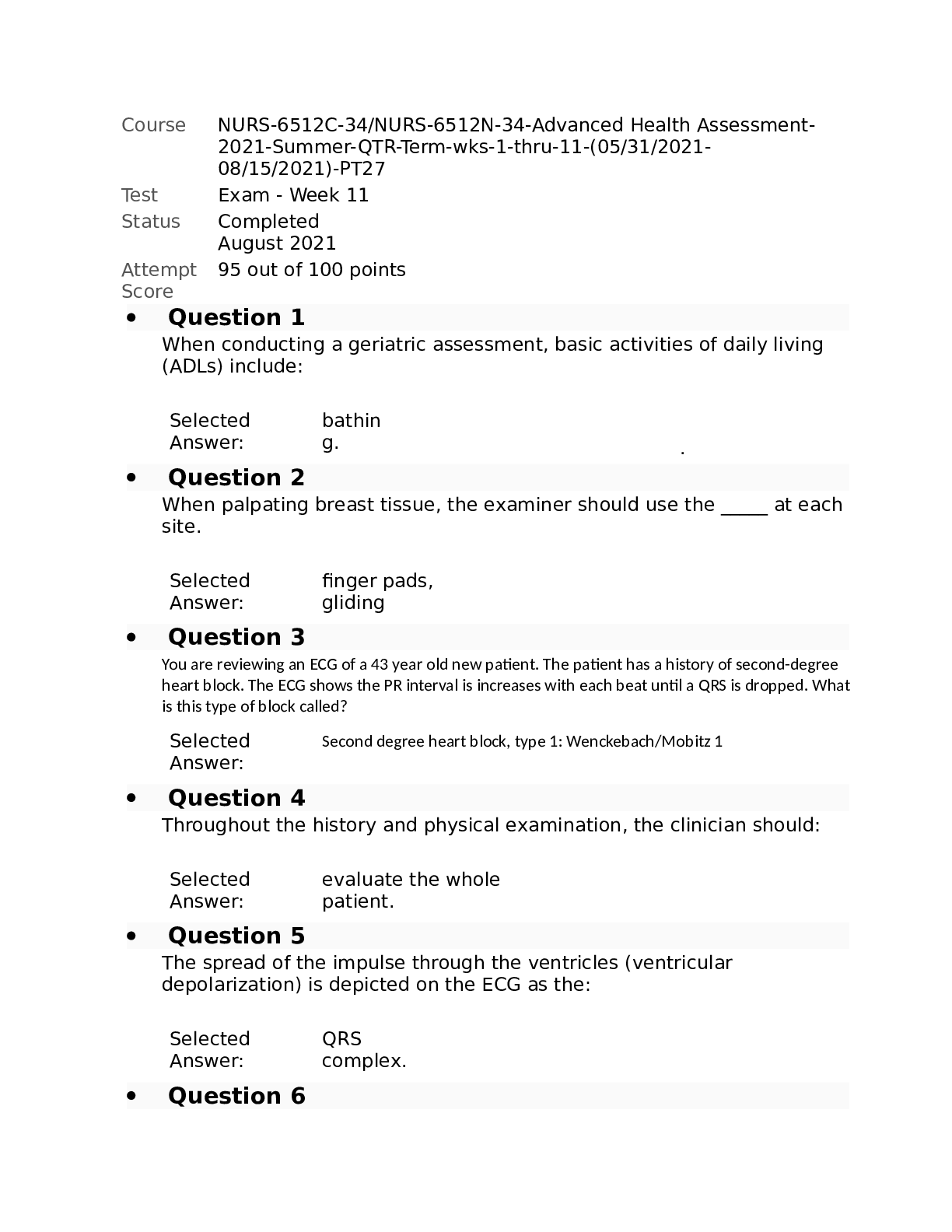*NURSING > EXAM > NRP 531 Assessment Final Exam 1, With complete answers: University Of Phoenix. (All)
NRP 531 Assessment Final Exam 1, With complete answers: University Of Phoenix.
Document Content and Description Below
NRP 531 Assessment Final Exam 1 Quiz Questions Question 1. What is the primary purpose of initially assessing an apical pulse? Question 2. What instruction should the nurse give nursi... ng assistive personnel (NAP) regarding the appropriate technique when measuring the adult patient’s apical pulse? Question 3. Which action would take priority if a patient’s apical pulse has an irregular rhythm? Question 4. Which statement demonstrates an understanding of the importance of communicating changes in the patient’s apical pulse rate? Question 5. The nurse can best determine the effect of crying on a patient’s apical pulse by doing what? Question 1. What is the major health problem resulting from a pulse deficit? Question 2. What should the nurse do when a pulse deficit is suspected? Question 3. Which action should the nurse perform after identifying a pulse deficit? Your Answer: B Question 4. You have the following information: Oral temperature–36.8°C. Radial Pulse–112 weak, thready Apical pulse–117 regular Respirations–24 regular Blood Pressure–104/56 right arm –102/50 left arm What is the pulse deficit? Question 5. Which of the following is an early manifestation of decreased cardiac output? Your Answer: A Fatigue Question 1. A nurse is caring for a patient who has just had major abdominal surgery to resect a portion of his colon. What is the most reliable sign that the patient has significant postoperative pain? Question 2. What will the nurse instruct nursing assistive personnel (NAP) to do regarding the management of a patient’s pain? Question 3. Which observation indicates that a patient’s analgesic has been effective in managing pain that she rated a 6 out of 10 on a pain rating scale before the intervention? Question 4. A patient with a herniated disk is scheduled for surgery to fuse two vertebrae in her cervical spine. Which activity is most likely to be a palliative factor for this patient? Question 5. The nurse notices that his patient has none of the signs and symptoms normally associated with pain, such as diaphoresis, tachycardia, and hypertension. The patient does, however, seem moody and a bit uncooperative. What conclusion does the nurse draw? Your Answer: C The absence of physiological signs and symptoms is associated with chronic pain. Question 1. During the admissions process, the nurse initially assesses the patient’s radial pulse primarily for what purpose? Question 2. What will the nurse instruct nursing assistive personal (NAP) to do when measuring an adult patient’s radial pulse? Question 3. What is the nurse’s priority action if a patient’s radial pulse has an irregular rhythm? Question 4. Inadequate oxygenation to the body will cause the radial pulse to become: Question 5. Which action would best assess the effect of exercise on a patient’s radial pulse measurement? Question 1. Which action can the nurse take to keep a patient from consciously controlling his or her breathing during an assessment? Question 2. On the last assessment of a patient’s respiration, her respiratory rate was 10 breaths per minute. What should the nurse do when conducting the next assessment of this patient’s respiratory rate? Question 3. When measuring a patient’s respiratory rate, the nurse will count the number of completed respiratory cycles per minute. What is the definition of a respiratory cycle? Question 4. During the assessment of a patient’s respiratory rate, when the second hand reaches the 15-second mark, the respiratory count is 8. What should the nurse do at this time? Question 5. The nurse plans to assess a patient’s respiratory rate; however, the patient has just returned from ambulating to the bathroom. What should the nurse do to minimize the effect of exercise on the patient’s respiratory rate? Question 1. What is the correct order for abdominal assessment? Question 2. How often should normal bowel sounds be heard in each quadrant of the abdomen? Question 3. Which of the following is an important part of performing an abdominal assessment? Question 4. What should you do if a patient is ticklish when you are palpating the abdomen? Question 5. Moderate and deep palpation of the abdomen: Question 1. A nurse is palpating the breasts of a patient. Which of the following are important aspects of proper palpation of the breasts? Question 2. What is the most important information to document if a mass is palpated in the breast or axilla? Question 3. What are the five danger signs to watch for when assessing nipples? Question 4. Which of the following statements is the most complete description of the tail of Spence? Question 5. When assessing the breasts, which of the following is considered normal? Question 1. Which of the following methods is correct for examining the ear of an adult patient with an otoscope? Question 2. Assessment of the ears includes which of the following? Question 3. A nurse is inspecting the patient’s ears with an otoscope. Which of the following findings would be considered abnormal? Question 4. A whispered voice test includes which of the following? Question 5. The Rinne and Weber tests measure which of the following? Your Answer: A Air and bone conduction Question 1. When using the Snellen chart, what does a vision evaluation of 20/50 mean? Your Answer: D Both A and B. ________________________________________ Question 2. What term refers to the constriction of the pupils when a patient focuses on an object held about 10 centimeters from the nose? Your Answer: C Accommodation ________________________________________ Question 3. What does full movement of the eyes in the six cardinal fields of gaze reflect? Your Answer: A Both B and C ________________________________________ Question 4. When examining the eyes, which of the following is an expected finding? Your Answer: B Equal pupils ________________________________________ Question 5. Which of the following are risk factors for glaucoma? Your Answer: D All of the above Question 1. What is included in the preparation for an assessment of the female genitalia? Your Answer: D Both A and B ________________________________________ Question 2. When should gloves be changed or discarded? Your Answer: D All of the above ________________________________________ Question 3. Which description is consistent with normal vaginal secretions? Your Answer: B Clear or cloudy, and odorless or with a slight odor ________________________________________ Question 4. What is a Pap smear? Your Answer: A A screening test for cervical cancer ________________________________________ Question 5. Screening for endometrial cancer consists of reinforcing the need to report: Your Answer: C Unexpected vaginal bleeding or spotting Question 1. A nurse is assessing a patient’s neck. Which of the following is considered an expected finding? Your Answer: B Midline trachea ________________________________________ Question 2. Which symptom found when examining the head would be a cause for concern? Your Answer: C Bruits in the temporal arteries ________________________________________ Question 3. What information should be included when entering documentation of an enlarged lymph node? Your Answer: D All of the above ________________________________________ Question 4. When assessing lymph nodes, it is important to do which of the following? Your Answer: D Both comparing the lymph nodes bilaterally and providing privacy for the patient. ________________________________________ Question 5. Which lymph nodes are located in the depression above and posterior to the medial condyle of the humerus? Your Answer: C Epitrochlear lymph nodes Question 1. Where is the apical impulse located? Question 2. Auscultatory sites of the heart include: Question 3. Which of the following findings during a cardiac assessment of an adult patient are considered normal? Question 4. The S1 heart sound: Question 5. When palpating the carotid arteries: Your Answer: D Both A and B Question 1. Which of the following should be included in a male genital exam? Question 2. Nocturia, urine dribbles, difficulty voiding, and a small urine stream are common symptoms of which of the following conditions? Question 3. In which patient population does benign prostatic hypertrophy occur most commonly? Question 4. Which of the following patients are considered at increased risk for colon cancer? Question 5. Which possible signs and symptoms of testicular cancer should be reported to a physician? Question 1. Which of the following techniques is used to assess muscle strength in a patient? Your Answer: A Question 2. What is an increased thoracic curvature, common in older adults, called? Question 3. Neck flexion and extension should be: Question 4. Which of the following findings in a musculoskeletal assessment would be considered abnormal? Question 5. What does a goniometer measure? Question 1. What questions can you ask a patient to assess his or her state of consciousness? Question 2. Which of the following cranial nerves is assessed by holding a scented object under the patient’s nose? Question 3. What are the Snellen and Rosenbaum charts used to assess? Question 4. Which of the following are included in the assessment of mental status? Question 5. Which of the following actions are part of the assessment of the glossopharyngeal and vagus nerves? Question 1. Which test or tests assess accuracy of movement? Question 2. What should the nurse do if a patient displays staggering or loss of balance during the Romberg test? Question 3. How would you assess sensitivity to superficial pain? Question 4. A deep tendon reflex with a normal response is scored as: Question 5. Which of the following tips will assist with eliciting the patellar and Achilles deep tendon reflexes? Your Answer: B Have the patient focus on pulling his or her clasped hands apart. Question 1. Which of the following is the correct way to assess a patient’s nose for patency? Question 2. What is the correct way to palpate the frontal sinuses? Question 3. The gag reflex should be: Question 4. Which structures are included in a complete assessment of the mouth? Question 5. During vocalization, the soft palate: Raises symmetrically Question 1. In which position should the patient be placed in order to palpate the popliteal pulse? Question 2. Hearing a bruit in an artery is a sign of which of the following conditions? Question 3. What is a depression that is left after pressing a finger or thumb on swollen tissue called? Question 4. Normal capillary refill is less than 2 seconds and is assessed by: Question 5. When should you check the patient’s blood pressure to assess for orthostatic hypotension? While the patient is sitting and standing Question 1. Skin inspection and palpation includes assessment for: Question 2. An ABNORMAL angle between the nail base and the nail is called clubbing and may indicate which of the following conditions? estion 3. Which are the best places to check the skin for tenting, which is a sign of dehydration? Question 4. Which of the following is considered an ABNORMAL finding in an older adult? Question 5. The ABCD rule of melanoma includes: Question 1. Which of the following indicates normal respiratory function? Your Answer: A Question 2. When palpating the thorax, which of the following would be an abnormal finding? Your Answer: D Question 3. When percussing the thorax, which of the following would be a normal finding? Your Answer: D Question 4. Normal breath sounds include: Your Answer: A Question 5. When auscultating the lungs, it is important to: Question 1. A patient who had surgery yesterday has the initial dressing covering the surgical site. What is the nurse’s responsibility in assessing this patient’s wound? Question 2. Which wound would be allowed to heal by secondary intention? Question 3. Before performing a wound assessment, which nursing action would reduce the patient’s risk for infection? Question 4. Which intervention can the nurse delegate to nursing assistive personnel (NAP) in caring for a patient with a wound? Question 5. The nurse notes that a patient’s surgical wound is healing slowly. Which health problem would contribute to slow wound healing? Question 1. The nurse determines that the patient has “the baby blues.” Which statement by the patient indicates a need for further teaching? Question 2. Which of these factors indicates a greater risk for postpartum depression? Question 3. The nurse is assessing new mothers for postpartum depression. Which of these behaviors would indicate a need for immediate action? Question 4. The nurse is assessing a patient who is speaking rapidly and emphatically, but seems confused and frequently addresses questions you have not asked as if speaking to someone who is not in the room with you. By the end of the assessment, she has become quiet and withdrawn. The nurse suspects: Question 5. The nurse assesses the father’s responses to determine the presence of the baby blues or PPD only if: Question 1. A nursing report is an important component of care. During the report, what is the primary purpose of an effective exchange of information? Question 2. Which of the following strategies is safest when providing a recorded nursing report? Question 3. The progressive care unit uses a recorded system for nursing reports. In the past, nurses have designated positions in the chall where they could record and listen to reports. Now, the unit governance council has mandated that recording and listening to reports must be done in the medication room, nurse lounge, or dictation room. What is the reason for this change? Question 4. What is the benefit of completing a bedside report during hand-off? Question 5. When preparing a nursing report, which of the following steps should the reporting nurse take? Question 1. What is the nurse’s primary goal for appropriate, effective pain management when considering the patient’s risk for injury? Question 2. What is one step the nurse would take if a patient receiving patient-controlled analgesia (PCA) were difficult to arouse? Question 3. When a patient is using PCA, which statement is appropriate for the nurse to make to nursing assistive personnel (NAP)? Question 4. Which patient outcome best reflects adequate management for pain originally rated as 8 out of 10 on a pain scale? Question 5. What will the nurse do when discontinuing PCA? Question 1. When preparing to measure the height and weight of a newly admitted patient, why would the nurse ask about the patient’s ability to stand? Question 2. A nursing assistive personnel (NAP) is preparing to weigh a resident in a skilled nursing facility. The patient is usually weighed in street clothing and socks, with his shoes off. The patient is currently wearing street clothing with shoes and socks. What will the NAP do to ensure that the patient’s weight is correctly measured? Question 3. Which step must be taken to ensure accurate measurement of a patient’s daily weight? Question 4. As the nurse is conducting an admission interview, the patient states, “I’ve lost 30 pounds over the last 4 months.” Which question might the nurse ask to determine if the weight loss was intentional or unintentional? Question 5. For which patient would the nurse instruct nursing assistive personnel (NAP) to weigh a patient with a bed scale? Question 1. What is the primary purpose of the preoperative assessment? Question 2. What is the best way for the nurse to assess a preoperative patient for possible latex allergy? Question 3. Which part of the preoperative assessment might the nurse delegate to the nursing assistive personnel (NAP)? Question 4. On which areas would the nurse focus when completing a preoperative physical examination? Question 5. During a preoperative assessment, why would the nurse ask the patient about his or her response to previous surgeries? Question 1. What is the primary purpose of promoting preoperative family participation? Question 2. How will the nurse ensure privacy when discussing a patient’s surgical needs with the family? Question 3. Which statement or question by the nurse illustrates the role of nursing assistive personnel (NAP) in providing perioperative instruction to the family of a patient scheduled for surgery? Question 4. The family of a surgical patient is concerned about being able to provide the care the patient will need after surgery. What is the nurse’s best response? Question 5. How can the nurse evaluate a family’s anxiety concerning its role in providing the patient’s postsurgical care? Question 1. Why might a nurse teach a patient scheduled for surgery how to do postoperative exercises? Your Answer: B Question 2. Before teaching a patient postsurgical exercises, the nurse premedicates the patient for pain. What benefit does this have specific to the patient’s learning? Your Answer: B Question 3. What instruction might the nurse give to nursing assistive personnel (NAP) regarding postoperative exercises? Question 4. Which instruction might a nurse give a patient in order to protect a surgical incision when turning in bed? Question 5. The nurse is concerned that a patient will not be able to turn independently in bed after having surgery. What must the nurse do to help this patient? Chapter 1 Jarvis The concept of health and healing has evolve in recent years. Which is the best description of health? C. Health depends on an interaction of mind, body and spirit within the environment. Which would be included in the database for a new patient admission to a surgical unit? D. All subjective and objective, and data gathered from a patient and the results of any laboratory or diagnostic studied completed. You are reviewing assessment data of a 45-year-old male pt and note pain of 8 on a scale of 10, labored breathing, and pale skin color on the EMR. This documentation is an example of: C. Data cluster A pt is in the emergency department with N/V. Which would you include in the database? B. A diet and GI history A pt has recently received health insurance and would like to know how often he should visit the provider. How do you respond? C. "Your visits may vary, depending on your level of wellness." You are reviewing concepts related to steps in the nursing process for determining prioritization and developing patient outcomes. To what are these actions attributed? A. Planning Which best describes evidence-based nursing practice? A. Combining clinical expertise with the use of nursing research to provide the best care for patients while considering the patient's values and circumstances. What can be determined when the nurse clusters data as part of the critical- thinking process? C. The nurse recognizes relevant information among the data. A patient says she is very nervous and nauseated, and she feels like she will vomit. This data would be what type of data? C. Subjective The expert nurse differs from the novice nurse by acting without consciously thinking about the actions. This is referred to as: B. Intuition Which would be considered a risk of diagnosis? C. Identifying potential problems the individual may develop Which would be included in a holistic model of assessment? C. A patient's perception of his or her health status The nurse uses health promotion activities with a new patient. What would this focus include? D. The nurse would empower the patient to choose a healthier lifestyle. Which is an example of objective data? D. 2- X 5-cm scar present on the right lower forearm. During the evaluation phase of the nursing process, which action would be included? C. Providing information to the patient and family members. Chapter 3 Jarvis The practitioner, entering the examining room to meet a patient for the first time, states: "Hello, I'm M.M., and I'm here to gather some information from you and to perform your examination. This will take about 30 minutes. D.D. is a student working with me. If it's all right with you, she will remain during the examination." Which of the following must be added to cover all aspects of the interview contract? A. A statement regarding confidentiality, patient costs, and the expectations of each person. _______ is exhibiting an accurate understanding of the other person's feelings within a communication context. B. Have someone else answer the phone so you can sit facing the patient. A patient asks the nurse, "May I ask you a question?" This is an example of: C. A closed question Which statement best describes interpretation as a communication technique? D. Interpretation is based on the interviewer's inference from the data that have been presented. Which demonstrates a good understanding of the interview process? B. The nurse spends more time listening to the patient than talking. During an interview, a patient denies having any anxiety. The patient frequently changes position in the chair, and has little eye contact with the interviewer. The interviewer should: A. Use confrontation to bring the discrepancy between verbal and nonverbal behavior to the patient's attention. For what or with whom should touch be used during the interview? D. Only if the interviewer knows the person well Children usually come for health care with a parent. At about what age should the interviewer begin to question the child himself or herself regarding presenting symptoms? B. 7 years Because of adolescents' developmental level, not all interviewing techniques can be used with them. Which techniques should be avoided? D. Silence and reflection Knowledge of the use of personal space is helpful for the health care provider. Personal distance is generally considered to be: B. 1 1/2 to 4 feet Mr. B tells you "Everyone here ignores me." You respond, "Ignores you?" This technique is best described as: C. Reflecting What does active listening NOT include? A. Taking detailed notes during the interview When interviewing a patient who does not speak English, the examiner should: B. Use a qualified medical interpreter who is culturally literate With older adults, how should the examiner proceed with the interview? B. Consider the fatigue of the older person and break the interview into shorter segments. Chapter 4 Jarvis When reading a medical record, you see the following notation: Patient states "I have had a cold for about a week, and now I am having difficulty breathing." This is an example of: a reason for seeking care You have reason to question the reliability of the information being provided by a patient. One way to verify the reliability within the context of the interview is to: rephrase the questions later in the interview The statement "Reason for seeking care" has replaced chief has replaced "Chief complaint." This change is significant because: the newer term incorporates wellness needs During an initial interview, the examiner says, "Mr. J., tell me what you do when your headaches occur." With this question, the examiner is seeking information about: aggravating or relieving factors What is an appropriate recording of a patients' reason for seeking health care? "grabbing" chest pain for 2 hours A genogram is useful in showing information concisely. It is used specifically for: family history What is a description of "review of systems" as part of the health history. the evaluation of the past and present health state of each body system What is an example of a subjective observation? pain lasting 2 hours When taking a health history for a child, what information, in addition to that for an adult, is usually obtained? a review of the immunizations recieved Functional assessment measures how a person manages day-to-day activities. The impact of a disease on the ADL's in older adults is referred to as: disease burden Which two sections of the child’s health history become separate sections because of their importance to the childs current health status? Developmental and nutritional history Which statement best describes the purpose of a health history? To provide a data base of subjective information about the patient’s past and present health While assessing a man for allergies, he states he is allergic to penicillin. Which response is best? Please describe what happens to you when you take penicillin The mnemonic PQRSTU is helpful for organizing the critical characteristics of a symptom. What do the letters mean? Perceptions Qualities Relieving factors Strength How bad is it? Time When did it occur? You what does it mean to you? What two sections of the child's health history become separate sections because of their importance to current health status. developmental and nutritional history Chapter 5 Jarvis Although a full mental status examination may not be required, you must be aware of the 4 main headings of the assessment while performing the interview and physical examination. These headings are: D. Appearance, behavior, cognition, and thought process. Select the finding that most accurately describes appearance of a patient. A. Tense posture and restless activity. Clothing clean but not appropriate for season (ex patient wearing T-shirt and shorts in cold weather.) You are assessing short-term cognitive function. Which assessment shows the ability to lay down new memories? D. Use of the Four Unrelated Words Test You are preparing the discharge plan for a patient with aphasia. What assessment should you include in the plan? C. Ask the patient to demonstrate word comprehension by naming articles in the room or on the body as you point to them. During an interview with a patient diagnosed with a seizure disorder, the patient states, "I plan to be an airline pilot." If the patient continues to have this as a career goal after teaching regarding seizure disorders has bee provided, you might question the patient's: B. Judgement On a patient's second day in an acute care hospital, the patient complains about the "bugs" on the bed. The bed is clean. This would be an example of altered: C. Perception One way to access cognitive function and to screen dementia is with: B. The Mini-Cog A major characteristic of dementia is: A. Impairment of short-and-long-term memory. What statement is an example of a patient with dysarthria? B. The word choice and grammar are appropriate, but the sounds are distorted so speech is unintelligible. You are leading a discussion of the planned activities for the day at an adult living center and state, "We will be having snacks at 9:30 and lunch will be at noon." One of the participants responds in a very monotone manner, "Snacks at 9:30, lunch at noon, snacks at 9:30, lunch at noon." This patient is exhibiting signs of: A. Echolalia You are performing a mental status examination. Which assessments would be most appropriate? C. Observing the patient and inferring health or dysfunction. When assessing mental status in children, what statement is true? A. All aspects of mental status in children are interrelated. You are assessing a 75-year-old man. What is an expected finding? C. It may take him a little longer to respond but his general knowledge and abilities should not have declined. What is a priority assessment of aging adults? D. Sensory perceptive abilities Chapter 6 Jarvis The phase of addiction characterized by tolerance, increasing time spent in substance-related activities, unsuccessful attempts to quit and continued use despite known harm is: Dependency The unpleasant effect that occurs when use of a drug is stopped is called: Withdrawal The need for increasingly larger doses of a substance to achieve the same effect that was initially experienced from using is called: Tolerance Which health issue is NOT a result of prolonged heavy drinking? Increased resistance to pneumonia and other infectious diseases How many drinks does a person consume in one sitting for it to be considered binge drinking? 5 A pregnant woman explains she does not intend to stop drinking because her friends continued to drink during pregnancy, and "nothing happened" to them or their kids. How should the clinician respond? "No amount of alcohol has been determined to be safe for a pregnant woman so I would ask you to stop drinking alcohol completely." Which is the most commonly used laboratory test to identify chronic alcohol drinking? Gamma-glutamyl transferase (GGT) The CAGE screening tool is used to assess: Problem alcohol use While assessing a man during a physical exam for work, you suspect alcohol use. Which assessment tool is appropriate in this situation? AUDIT screening tool You are screening patients for excessive alcohol consumptions. Which patient would be considered over the recommended limit? Woman who reports drinking 2 glasses of wine and 2 vodka martinis each day You are performing a sports physical on a 16year old girl. Which question would be more likely yield an accurate substance abuse assessment? "Many teenagers have tried street drugs. Have you tried these drugs?" During the assessment, you will observe which problems in addition to alcohol withdrawal syndrome? Pancreatitis You are assessing a pt's cardiac risk factors secondary to chronic alcohol use. Which condition might this patient exhibit? Hypertension You are assessing a male pt's alcohol consumption. Which statement would alert you to investigate further? "No matter how much I drink I don't get drunk" Chapter 7 Jarvis Which scenario is an example of intimate partner violence? D. All of the above - An ex-boyfriend stalks his ex-girlfriend - Marital Rape - Hitting a date Routine universal screening for domestic violence includes: A. Asking all women each time they come to the health care system if they are abused. Patients are at a high risk for which mental health problem associated with intimate partner violence? B. Suicidality Which gynecologic problem is not usually associated with intimate partner violence? B. Ovarian cysts Risk factors for intimate partner homicide include: A. Abuse during pregnancy Elder abuse and neglect assessments include: E. All of the above - willful infliction of force - withholding prescription medications without medical orders - Not replacing broken eyeglasses - threatening to place someone in a nursing home When assessing an injury on a child, which should be considered? D. All of the above - The child's developmental level - The child's medical and medication history - The history of how the injury occurred What is a known risk factor for child maltreatment? D. All of the above - Substance abuse - Intimate partner violence - Physical disability and/ or mental retardation in the child Bruising on a non-walking or non-cruising child: B. Needs to be further evaluated for either an abusive or medical explanation Which is a forensic term that is related to "purpura" but is not related to blunt force trauma? C. Ecchymosis Which should be routinely included in evaluating a case of elder abuse? B. Baseline laboratory tests During an examination, you notice a patterned injury on a patient's back. Which is most likely? D. A welt from a leather belt During an interview, a woman has answered "yes" to 3 Abuse Assessment Screen questions. How should you proceed? B. Proceed by asking more questions about the items she answered "yes." Which clinical situation would require the examiner to report to the proper authorities? D. Suspicion of elder abuse and/or neglect Which would you include on the chart of the patient who has been the victim of abuse? A. Photographic documentation of injuries Chapter 8 Jarvis During the assessment, which part of the hand is best for detecting vibration? D. Ulnar surface of the hand When performing indirect percussion, the stationary finger is struck: C. At the distal interphalangeal joint The best description of the pitch of a sound wave obtained by percussion is: B. The number of vibrations per second The bell of the stethoscope is used: A. For soft, low-pitched sounds The ophthalmoscope has 5 apertures. Which aperture is used to access the eyes of a patient with undilated pupils? C. Small At the conclusion of the patient examination, the examiner should: D. Summarize findings to the patient. When the examiner enters the examining room, the infant patient is asleep. Which assessment should the examiner perform next? C. Heart, lung, and abdomen The sequence of an examination changes from beginning with the thorax to that of head to toe when the patient is in what age category? C. The school-aged child When inspecting the ear canal of a patient, the examiner chooses which speculum for the otoscope? D. The largest that will fit For a health assessment, which assessment technique will you use first? B. Inspection To assess a patient's abdomen by palpation, how should the nurse proceed? D. Start with light palpation to detect surface characteristics and to accustom the patient to being touched. Chapter 9 Jarvis The 4 areas to consider during the general survey include: D. Physical appearance, body structure, mobility, and behavior You are assessing a patient's gait. What do you expect to find? C. Gait is as wide as the shoulder width. An 18-month-old child is brought into the clinic for a health screening visit. To assess the height of the child: B. Use a horizontal measuring board. Which changes in head circumference measurements in relation to chest measurements will occur from infancy through early childhood? C. The newborn's head will be 2 cm larger than that chest circumference, but between 6 months and 2 years, the chest size will increase and remain the way. Which changes regarding height and weight occur during the 80s and 90s? C. Both decrease During an initial home visit, the patient's temperature is noted to be 97.4 F. How would you interpret this? A. It cannot be evaluated without knowledge of the person's age. Select the best description of an accurate assessment for a patient's pulse. B. Begin counting with zero; count for 30 seconds. After assessing the patient's pulse, the practitioner determines it to be "normal." This would be recorded as: B. 2+ Select the best description of an accurate assessment of a patients' respirations. D. Count for 30 seconds after pulse assessment. Pulse pressure is described as: A. The difference between the systolic and diastolic pressure. The examiner suspects a patient has coarctation of the aorta. Which assessment finding supports this suspicion? D. The pressure is lower than in the arm. Mean arterial pressure is: C. Diastolic pressure plus one third of the pulse pressure. Why is it important to match the appropriate size of blood pressure cuff to the person's arm and shape and not the person's age? A. Using a cuff that is too narrow will give a false reading that is high. A patient is being seen in the clinic for complaints of "fainting episodes that started last week." How should you proceed with the examination? C. Record the blood pressure in the lying, sitting, and standing positions. The nurse is conducting a health fair for older adults. Which statement is true regarding vital sign measurements in aging adults? B. An increased respiratory rate and a shallower inspiratory phase are possible findings. Chapter 11 Jarvis The balance between nutrient intake and nutrient requirements is described as: Nutritional status You are providing health promotion teaching for a newly pregnant woman, and recommend which of the following weight gain parameters for a healthy pregnancy? The recommendations depend on the BMI of the mother at the start of the pregnancy Which is a normal expected change with aging? Decrease in height You obtain which data when screening patients for nutritional status? Weight and nutrition intake history A 24-hour recall of dietary intake is used: As a questionnaire or interview of everything eaten within the last 24 hours Mary, a 15-year old, has come for a school physical. During the interview, you learn that menarche has not yet occured. The BMI is 17. You suspect: Nutritional deficiency Which older adult is at lowest risk for alteration in nutritional status? 65-year-old widower who visits a senior center with a meal program 5 days per week The examiner is completing an initial assessment for a patient admitted to a long-term facility. The patient is unable to stand for a measurement of height. To obtain this important anthropometric information, the examiner would: Measure arm span Which assessment finding indicated a patient at nutrition risk? Waist circumference at 43 inches Marasmus is often characterized by: Low weight for height Which BMI category in adults is indicative of obesity? 30.0 to 39.9 kg/m² Why should you ask about the use of medications when assessing a patient's nutritional status? Many drugs can interact with nutrients and impair their digestion, absorption, metabolism, or uptake Chapter 12 Jarvis Select the best description of the secretion of the eccrine glands. Dilute saline solution To assess for early jaundice, you will assess: Sclera and hard palate Checking for skin temperature is best accomplished by using: The dorsal surface of the hands. Assessing a patient's skin turgor is done to assess which clinical finding? Dehydration You note a lesion during a skin assessment. Which is the best way to document this finding? Dark brown raised lesion, with irregular border, on dorsum of right foot, 3 cm in size, with no drainage You examine the nail beds of a patient. Which finding indicates a normal angle? 160 degrees You are assessing capillary refill. The room is warm. Which finding would be considered normal? <1 second During a routine visit, M.B., age 78, asks about small, round, flat, brown macules on the hands. What is your best response after assessing the areas? "These are the result of sun exposure and do not require treatment." An area of thin shiny skin with decreased visibility of normal skin markings is most likely: Atrophy Flattening of the angle between the nail and its base is: Described as clubbing. A configuration of individual lesions arranged in circles or arcs, as occurs with ringworm, is described as a Annular lesion The "A" in the ABCDE rule for skin cancer stands for: Asymmetry A risk factor for melanoma is: Skin that freckles or burns before tanning Herpes zoster infection (shingles) is characterized by: Lesion on only one side of body; does not cross midline Chapter 13 Jarvis 1. Which facial bones articulate at a joint instead of a suture? d. Mandible 2. Identify the blood vessel that runs diagonally across the sternomastoid muscle. c. External jugular vein 3. The isthmus of the thyroid gland lies just below the: b. Cricoid cartilage 4. Which is true regarding cluster headaches? a. They may be precipitated by alcohol and daytime napping. 5. Which is least likely to indicate a possible malignancy? d. Marked tenderness. 6. Providing resistance while the patient shrugs his or her shoulders is a test of which cranial nerve? d. XI 7. On examination, the infant's fontanels should feel: c. Firm, slightly concave, and well defined 8. If the thyroid gland were enlarged bilaterally, which maneuver would be appropriate for you to assess? d. Listen for a bruit over the thyroid lobes. 9. It is normal to palpate a few lymph nodes in the neck of a healthy person. What are the characteristics of these nodes? a. Mobile, soft, nontender 10. Cephalhematoma is associated with: a. Subperiosteal hemorrhage 11. Normal cervical nodes are: a. Smaller than 1 cm 12. A throbbing, unilateral pain associated with nausea, vomiting, and photophobia is characteristic of: c. Migrane headache 13. Bell palsy is characterized by: a. Unilateral paralysis of half of the face 14. You suspect an infant's head is of abnormal size and can use which procedure to verify these findings? b. Measuring tape Chapter 14 The palpebral fissure is: b) the open space between the eyelids The corneal reflex is mediated by cranial nerves: c) V and VII The retinal structures viewed through the opthalmoscope are: a) the optic disc, the retinal vessels, the general background, and the macula The examiner records "positive consensual light reflex." This is: b) the simultaneous constriction of the other pupil when one eye is exposed to bright light The thickening and yellowing of the lens due to aging is described as: d) Senile cataract You must be alert for which eye emergency symptoms? c) sudden onset of vision change Visual acuity is assessed with: a) the Snellen eye chart The cover test is used to assess for: c) muscle weakness When using the opthalmoscope, you would: a) remove your own glasses and approach the patient's left eye with your left eye. The six muscles that control eye movement are innervated by cranial nerves: c) III, IV, VI Conjunctivitis is always associated with: b) reddened conjunctiva A patient has blurred peripheral vision. You suspect glaucoma, and test the visual fields. A person with normal vision would see your moving finger temporally at: c) 90 degrees A person is known to be blind in the left eye. What happens to the pupils when the right eye is illuminated by a penlight beam? b) Both pupils constrict Use of the opthalmoscope: an interruption of the red reflex occurs when: a) there is an opacity in the cornea or lens One cause of visual impairment in aging adults is: b) glaucoma Chapter 15 Jarvis Using the otoscope, the tympanic membrane is visualized. The color of a normal membrane is: Pearly gray. Sensorineural hearing loss may be related to: Gradual nerve degeneration. Before examining the ear with the otoscope, the _____ should be palpated for tenderness. Pinna, tragus, and mastoid process. During the otoscopic examination of a child younger than 3 years, the examiner: Pulls the pinna down. In examining the ear of an adult, the canal is straightened by pulling the auricle: Down and back. Darwin's tubercle is: A congenital, painless nodule at the helix. When the ear is being examined with an otoscope, the patient's head should be: Tilted away from the examiner. The hearing receptors are located in the: Cochlea. The sensation of vertigo is the result of: Pathology in the semicircular canals. A common cause of a conductive hearing loss is: Impacted cerumen. Upon examination of the tympanic membrane, visualization of which of the following findings indicates the infection of acute purulent otitis media? Absent light reflex, reddened drum, bulging drum. Risk reduction for acute otitis media includes: Eliminating smoking in the house and car. When assessing hearing acuity in a 6 month-old child, the examiner should: Watch for head turning when saying the child's name. A patient with a head injury has clear, watery drainage from the ear: the examiner should: Asses for the presence of glucose in the drainage. The most common site of nosebleeds is: c) Kiesselbach plexus The sinus that are accessible to examination are the: d) frontal and maxillary The frenulum is: a) the midline fold of tissue that connects the tongue to the floor of the mouth The largest salivary gland is located: a) within the cheeks in front of the ear A 70-year-old woman complains of dry mouth. The most frequent cause of this problem is: b) related to medications she may be taking. During an inspection of the nares, a deviated septum is noted. The best action is to: b) document the deviation in the medical record in case the person needs to be suctioned. Oral malignancies are most likely to develop: d) in the mucosal "gutter" under the tongue. In a medical record, the tonsils are graded as 3+. The tonsils would be: c) touching the uvula The function of the nasal turbinates is to: a) warm the inhaled air The opening of an adult's parotid gland (Stensen's duct) is opposite the: d) upper 2nd molar A nasal polyp may be distinguished from the nasal turbinates for 3 of the following reasons. Which reason is false? a) The polyp is highly vascular. The examiner notes small, round, white, shiny papules on the hard palate and gums of a 2-month-old. What is the significance of this finding? c) This is a normal finding called Epstein pearls. When assessing the tongue, the examiner should: a) palpate the U-shaped area under the tongue. Chapter 17 Jarvis The reservoirs for storing milk in the breast are: lactiferous sinuses The most common site of breast tumors is: The upper outer quadrant During a visit for a school physical, the 13 year old girl being examined questions the assymetry of her breasts. The best response is: "One breast may grow faster than the other during development" When teaching the breast self-examination, you would inform the woman that the best time to conduct breast self-examination is: on the 4th to 7th day of the cycle You are providing health promotion teaching for a 40 year old woman. What is the current recommendation for women 40 years of age and older for breast cancer screening with mammography? Every year You are going to inspect a female patient’s breasts for retraction. The best position for this part of the examination is: Sitting with hand pushing onto hips A bimanual technique may be the preferred approach for a woman. with pendulous breasts During the examination of a 70 year old man, you notice gynecomastia. You would: review the medications for drugs that have gynecomastia as a side effect. During a breast examination, you detect a mass. Identify the description that is most consistent with cancer rather than breast disease. B. irregular, poorly defined, fixed During the examination of the breasts of a pregnant woman, you would expect to find: a blue vascular pattern over both breasts Which of the following women should not be referred to a physician for further evaluation? C. a 25 year old with asymmetric breasts and inversion of nipples since adolescence Any lump found in the breast should be referred for further evaluation. a benign lesion will usually have 3 of the following characteristics. Which one is characteristic of a malignant lesion? D. irregular shape Gynecomastia is: enlargement of the male breast Which is the first physical change associated with puberty in girls? breast bud development During the examination of a 30 year old women, she questions you about "the 2 large moles "that are below her left breast. After examining the area, how do you respond? "This appears to be a normal finding of supernumeray nipples, due to the small areolae and nipples that are present." Chapter 18 The manubriosternal angle is: A. The articulation of the manubrium and the body of the sternum. Select the correct description of the left lung. B. Narrower than the right lung with two lobes. You assess a patient who reports a cough. The characteristic timing of the cough of chronic bronchitis is described as: B. Productive cough for at least 3 months of the year for 2 consecutive years. Which of the following assessments best confirms symmetric chest expansion? A. Placing hands on the posterolateral chest wall with thumbs at the level of T9 or T10 and then sliding the hands up to pinch a small fold of skin between the thumbs. Absence of diaphragmatic excursion occurs with: C. Pleural effusion or atelectasis of the lower lobes You are auscultating breath sounds on a patient. Which of the following best describes how to proceed? B. Hold the diaphragm of the stethoscope against the chest wall; listen to one full respiration in each location, being sure to do side to side comparisons. Select the best description of bronchovesicular breath sounds. B. Moderate-pitched, inspiration equal to expiration. After examining a patient, you make the following notation: increased respiratory rate, chest expansion decreased on left side, dull to percussion over left lower lobe, breath sounds louder with fine crackles over left lower lobe. These findings are consistent with: D. Lobar pneumonia On examining a patient's nails, you note that the angle of the nail base is >160 degrees and that the nail base feels spongy to palpation. These findings are consistent with: C. Congenital heart disease and COPD On auscultating a patient, you note a coarse, low-pitched sound during both inspiration and expiration. This patient reports pain with breathing. These findings are consistent with: D. Pleural friction rub To use the technique of egophony, ask the patient to: B. Say "eeee" each time the stethoscope is moved. When examining for tactile fremitus, it is important is: C. Palpate the chest symmetrically. Pulse oximetry measures: A. Arterial oxygen saturation of hemoglobin. A pleural friction rub is best detected by: C. Auscultation A patient has a barrel-shaped chest, characterized by: A. Equal anteroposterior transverse diameter and ribs being horizontal. Chapter 19 Jarvis The precordium is: C. The area on the anterior chest overlying the heart and great vessels. Select the best description of the tricuspid valve B. Right atrioventricular valve The function of the pulmonic valve is to: C. Protect the orifice between the right ventricle and the pulmonary artery Atrial systole occurs: B. During ventricular diastole The second heart sound is the result is: D. Closing of the aortic and pulmonic valves The examiner has estimated the jugular venous pressure. Identify the finding that is abnormal. D. Patient elevated to 45 degree, internal jugular vein pulsation at 4 cm above sternal angle The examiner is palpating the apical impulse. Which is a normal-size impulse? B. Approximately 1 X 2 cm The nurse auscultates the pulmonic valve area in which region? B. Second left interspace Which description would differentiate a split S2 from S3? A. S3 is lower pitched and is heard at the apex. You auscultate a patient to rule out a pericardial friction rub. Which assessment technique is most appropriate? A. Listen with the diaphragm, patient sitting up and leaning forward, breath held in expiration. When auscultating the heart, your first step is to: A. Identify S1 and S2 You will hear a split S2 most clearly in which area? B. Pulmonic The stethoscope bell should be pressed lightly against the skin so that: C. The bell does not act as a diaphragm. A murmur is heard after S1 and before S2. This murmur would be classified as: C. Systolic (possibly benign) When assessing the carotid artery, the nurse should palpate: B. Medical to the sternomastoid muscle, one side at a time. Chapter 20 Jarvis A function of the venous system includes: A. Holding more blood when blood volume increases. Which of the following organs aid the lymphatic system? C. Spleen, tonsils, and thymus Ms. T has come for a prenatal visit. She reports dependent edema, varicosities in the leg, and hemorrhoids. What is the best response? C. "The symptoms are caused by the pressure of the growing uterus on the veins. They are usual conditions of pregnancy." A patient's pulse with an amplitude of 3+ indicates: B. Increased, full Inspection of a person's right hand reveals a red swollen area. To further assess for infection, you would palpate the: C. Epitrochlear node To screen for deep vein thrombosis, you would: D. Measure the widest point with a tape measure. During the examination of the lower extremities, you are unable to palpate the popliteal pulse. You should: A. Proceed with the examination. It is often impossible to palpate this pulse. You assess a patient who has 4+ edema of the right leg. What is the best way to document this finding? D. Very deep pitting, indentation last a long time. You assess a patient for arterial deficit in the lower extremities. After raising the legs 12 inches off the table and then having the person sit up and dangle the leg, the color should return to: B. 10 seconds or less. A 54-year-old woman with 5 children has varicose veins of the lower extremities. Her most characteristics sign is: D. Dilated, tortuous superficial bluish vessels. Atrophic skin changes that occur with peripheral arterial insufficiency include: A. Thin, shiny skin with loss of hair Intermittent claudication includes: C. Muscular pain brought on by exercise A known risk factor for venous ulcer development is: A. Obesity Arteriosclerosis is caused by: B. Loss of elasticity of the walls of blood vessels. Raynaud phenomenon occurs: B. In hands and feet as a result of exposure to cold, vibration, and stress. Select the sequence of techniques used during an examination of the abdomen. C. Inspection, auscultation, percussion, palpation Which of the following can be noted through inspection of a patient's abdomen? C. Venous pattern, peristaltic waves, and abdominal contour Right upper quadrant tenderness may indicate pathology in the: A. Liver, pancreas, or ascending colon Hyperactive bowel sounds are: D. All of the above - high pitched, rushing, tinkling The absence of bowel sounds is established after listening for: C. 5 full minutes Auscultation of the abdomen may reveal bruits of the _________ arteries. A. Aortic, renal, iliac and femoral The normal range of liver span in the right midclavicular line in the adult is: D. 6-12 cm The left upper quadrant (LUQ) contains the: D. Spleen A female patient has striae on the abdomen. Which color indicates long-standing striae? D. Silvery white Auscultating the abdomen is begun in the right lower quadrant (RLQ) because: A. Bowel sounds are always normally present here. A dull percussion note forward of the left midaxillary line is: D. Indicative of splenic enlargement Shifting dullness is a test for: A. Ascites Tenderness during abdominal palpation is expected when palpating the: C. Sigmoid colon A positive Murphy's sign is best described as: B. Pain felt when taking a deep breath when the examiner's fingers are on the approximate location of the inflamed gallbladder. [Show More]
Last updated: 1 year ago
Preview 1 out of 45 pages

Reviews( 0 )
Document information
Connected school, study & course
About the document
Uploaded On
May 04, 2020
Number of pages
45
Written in
Additional information
This document has been written for:
Uploaded
May 04, 2020
Downloads
0
Views
142


